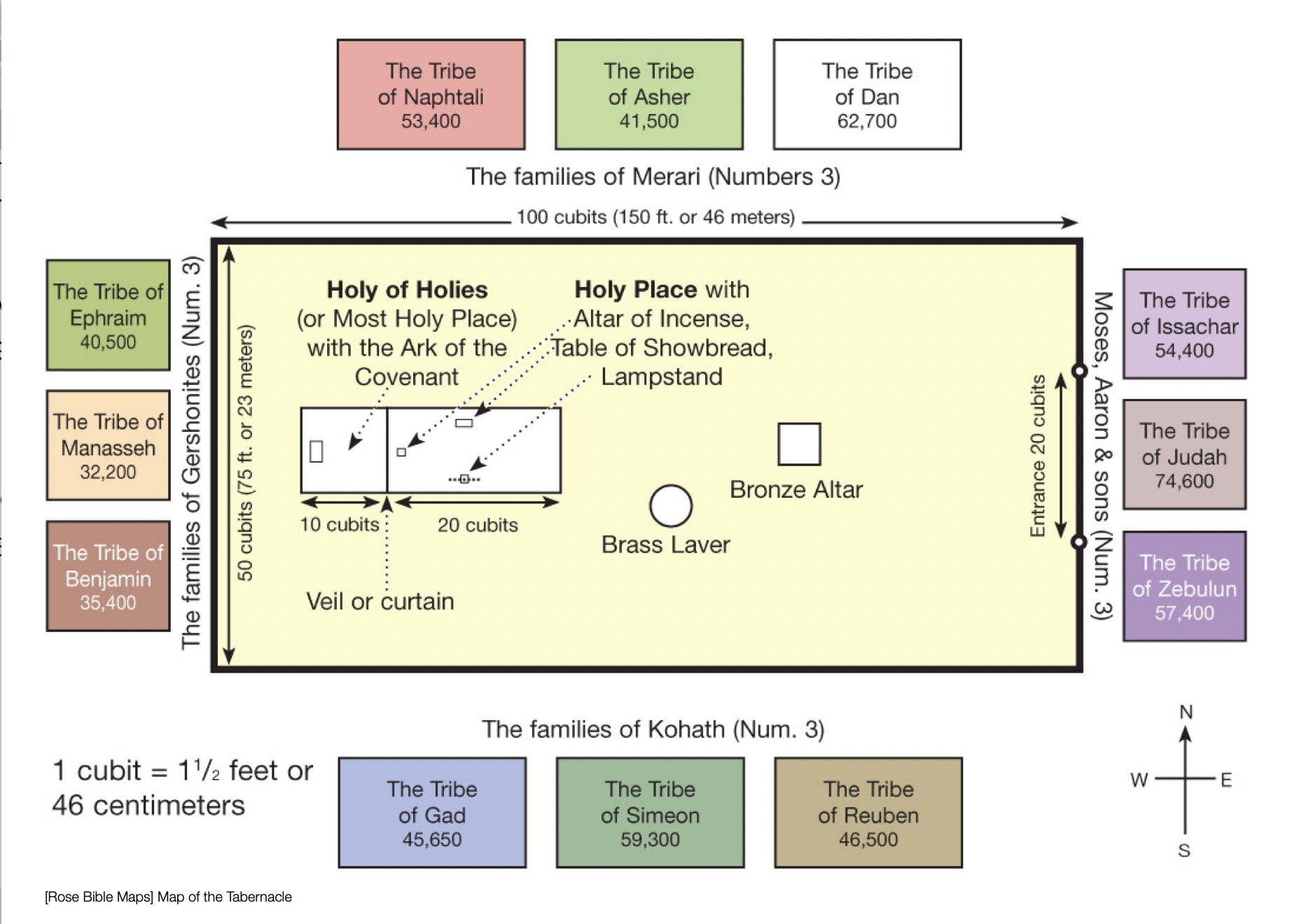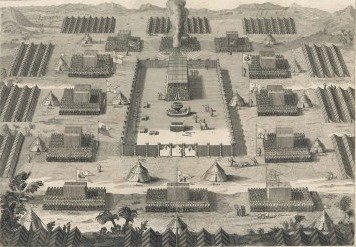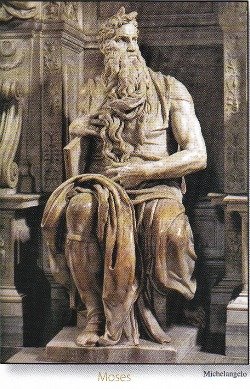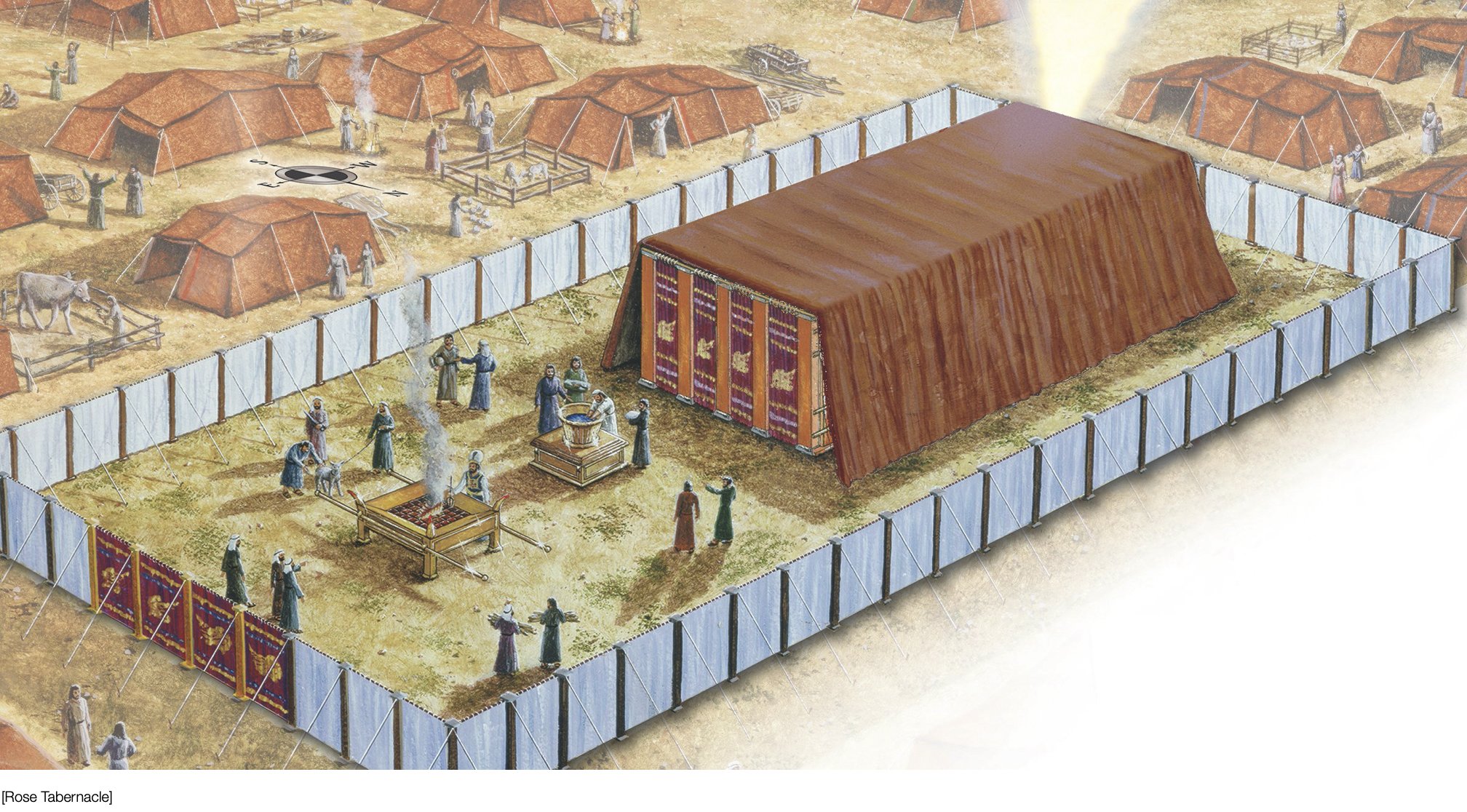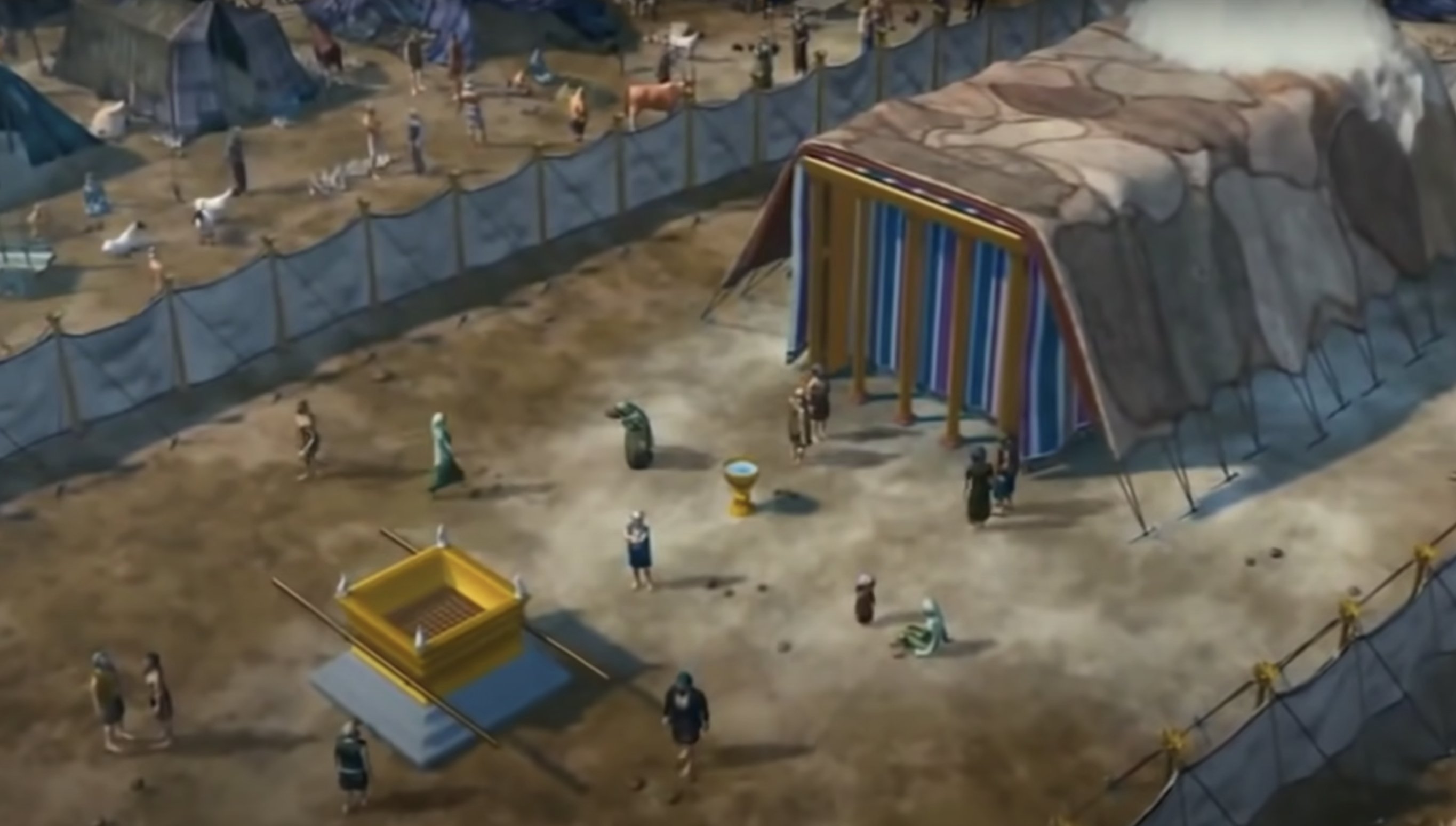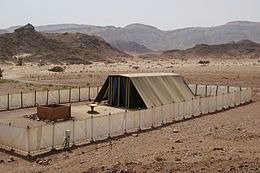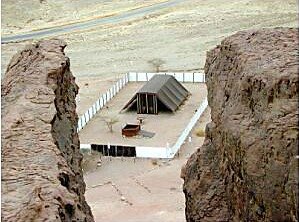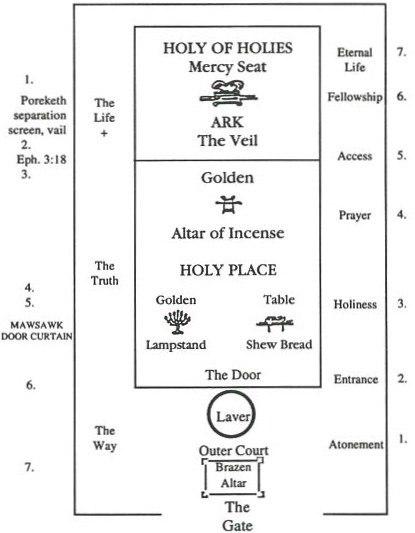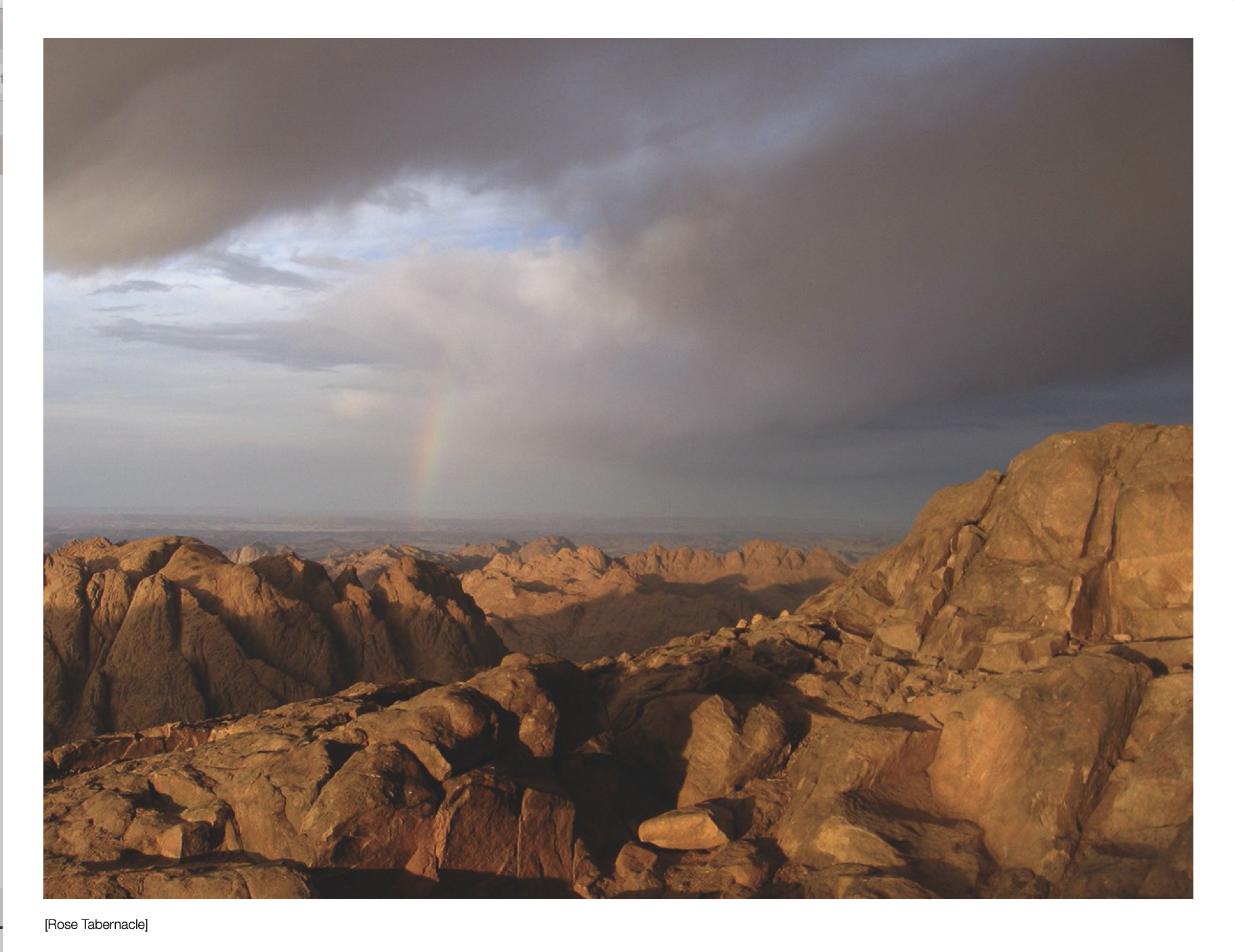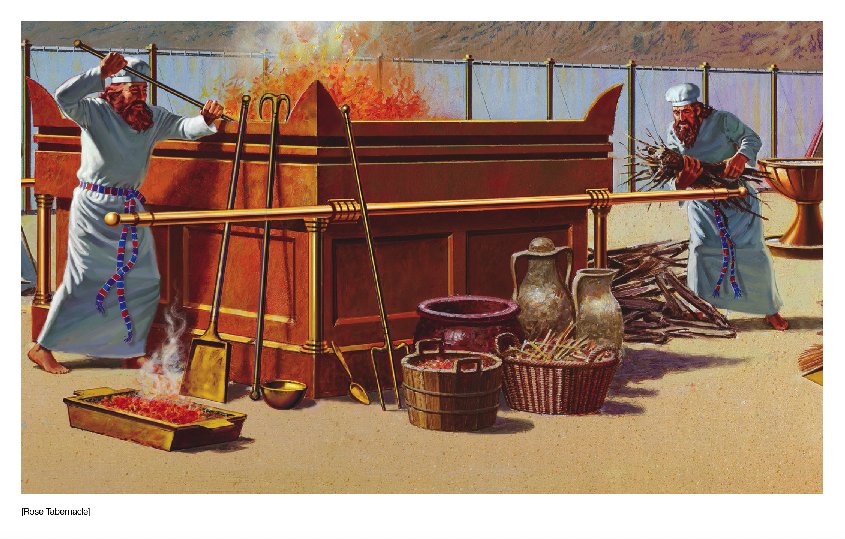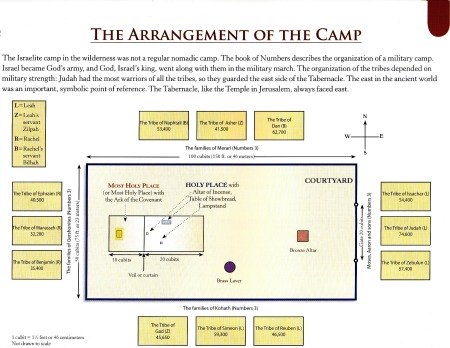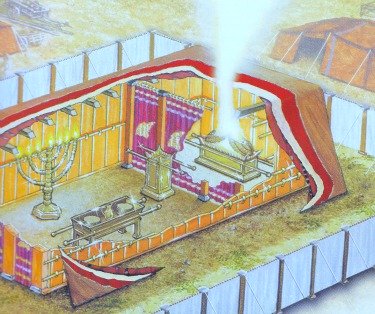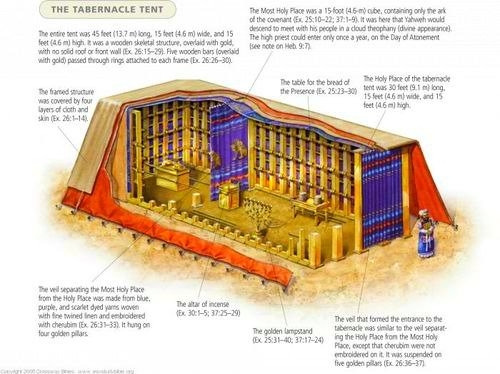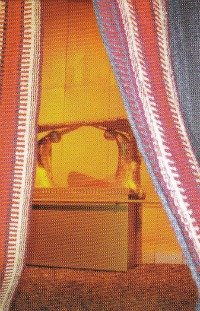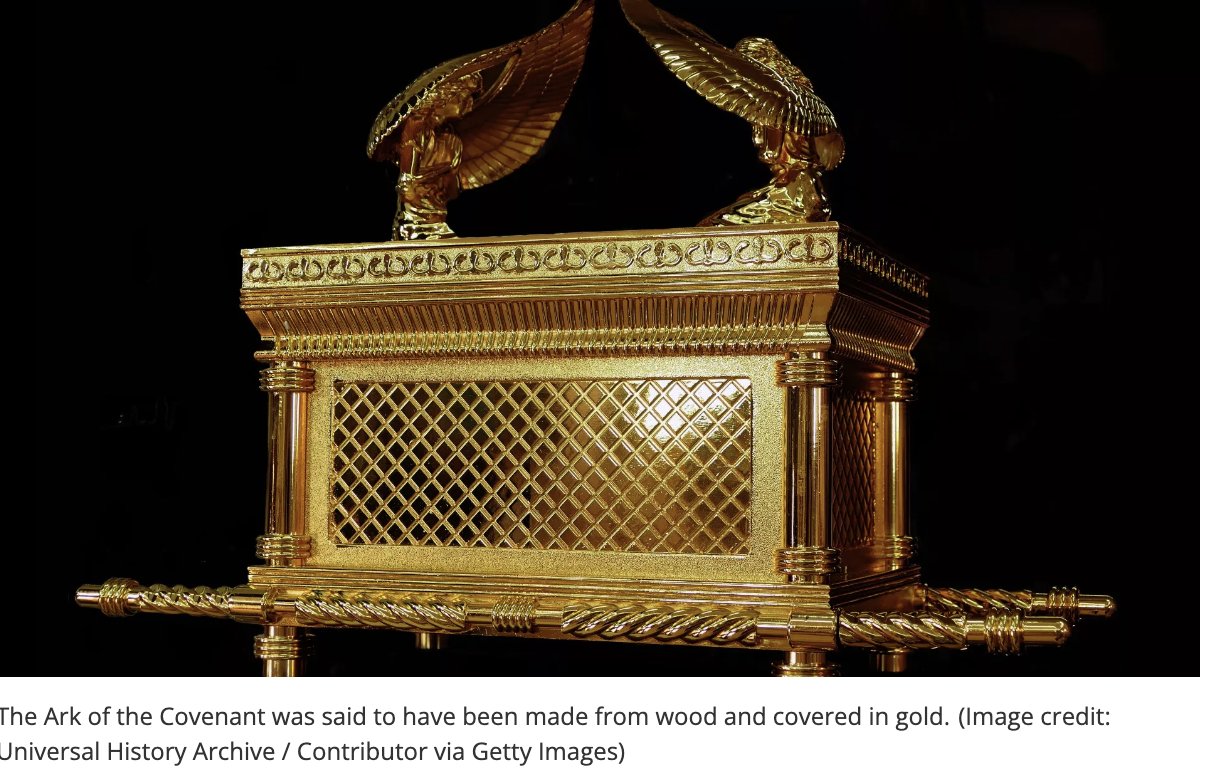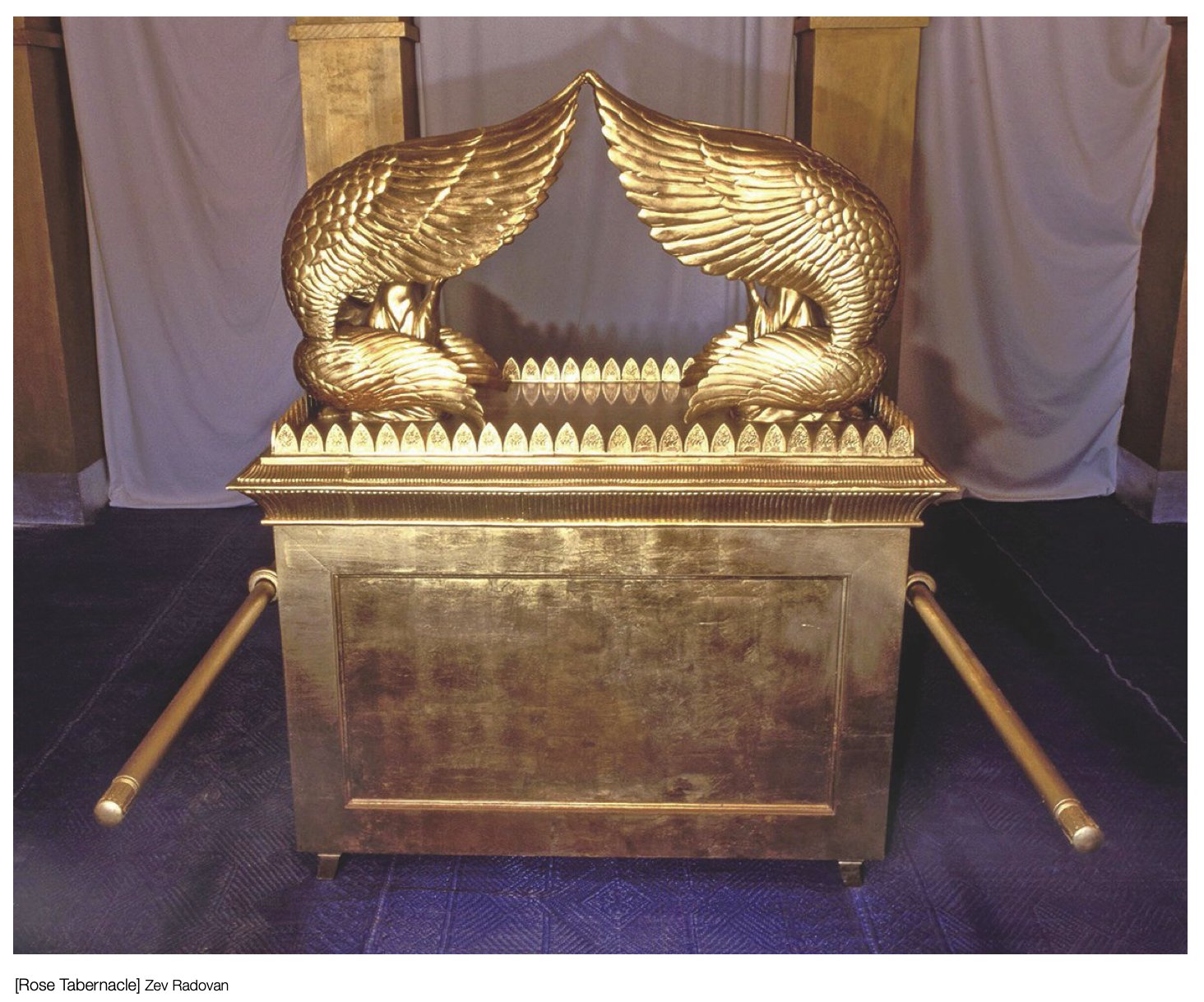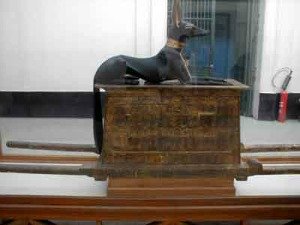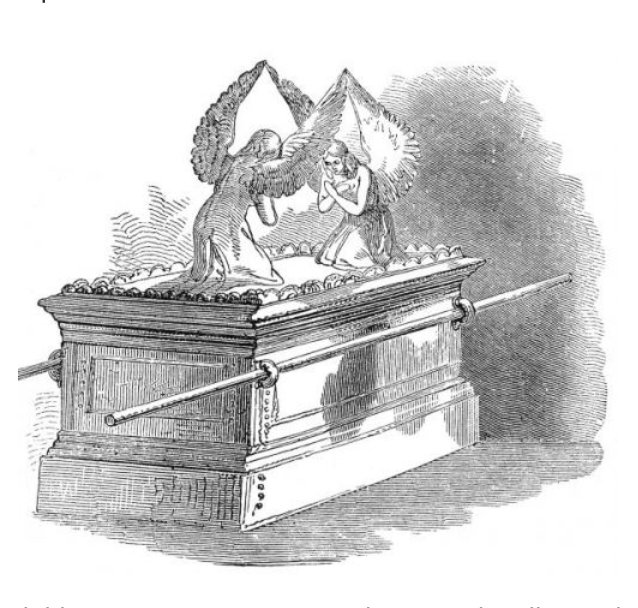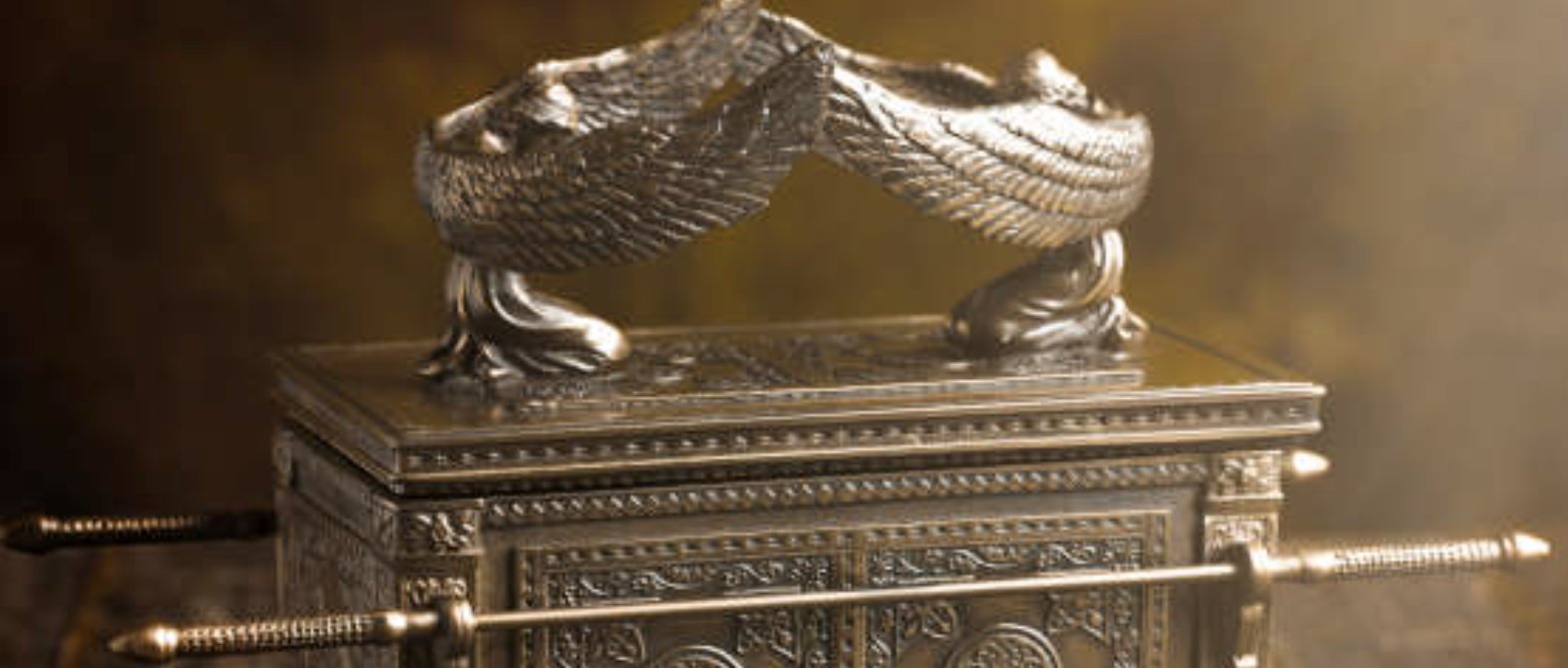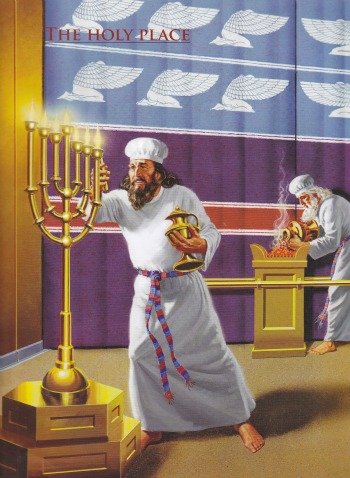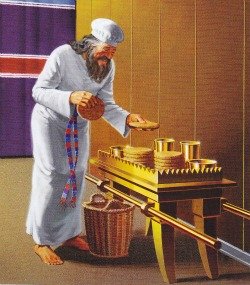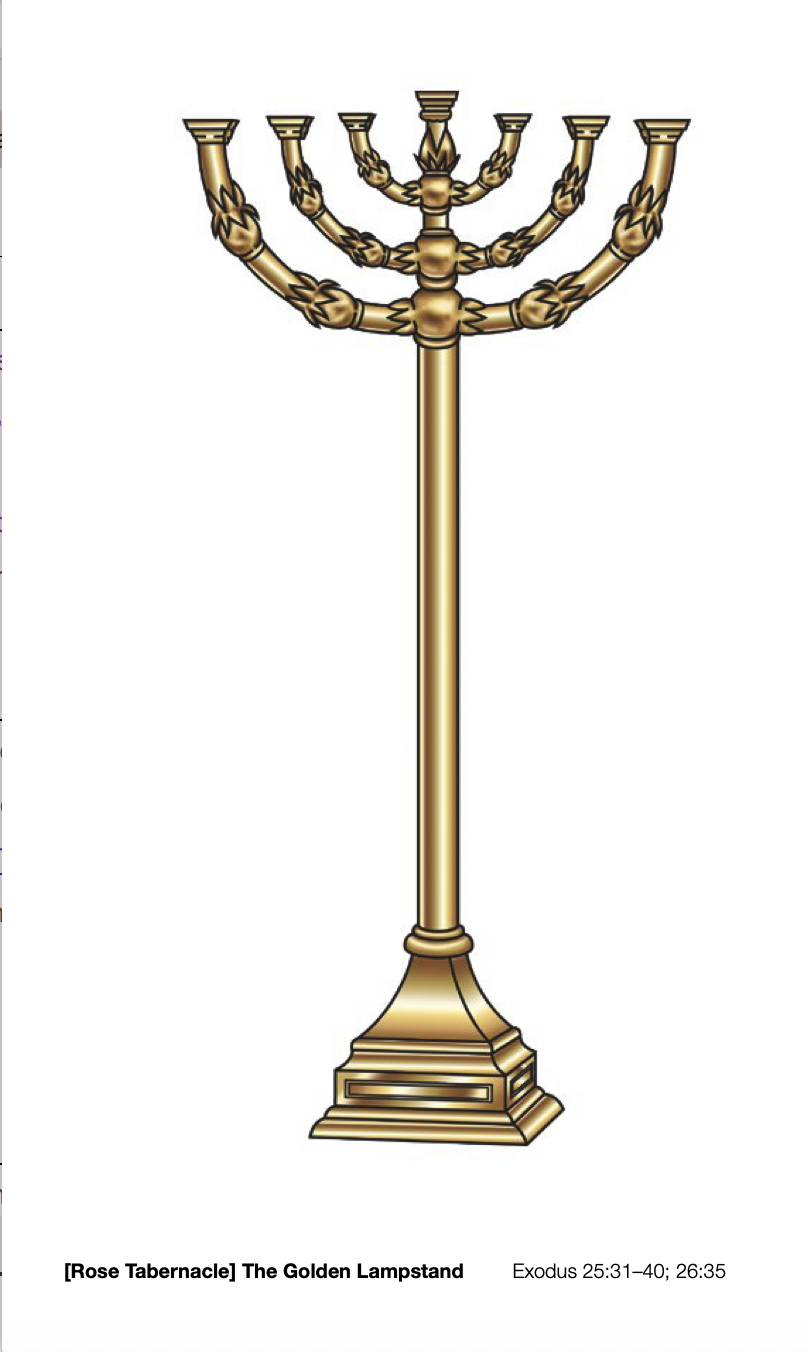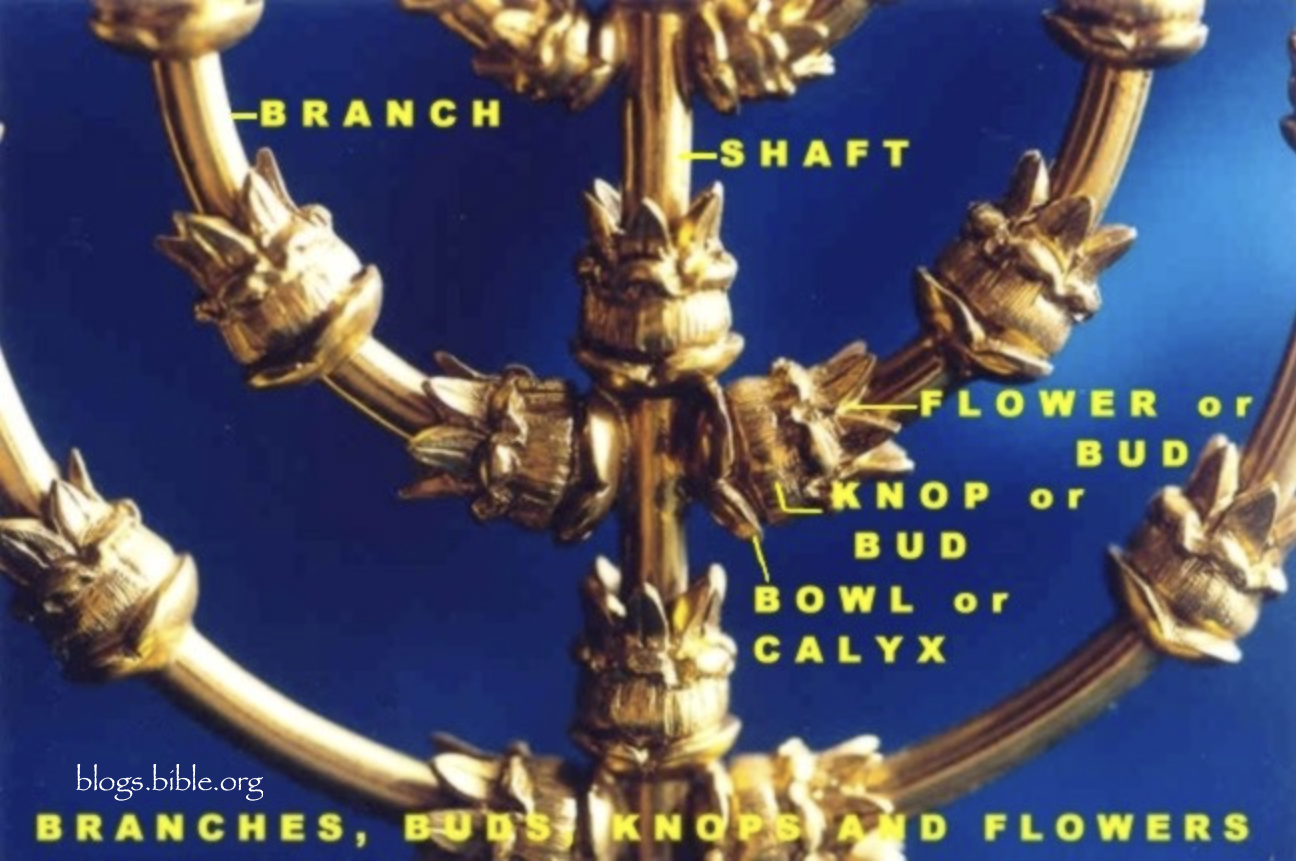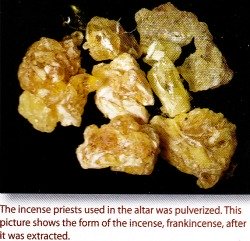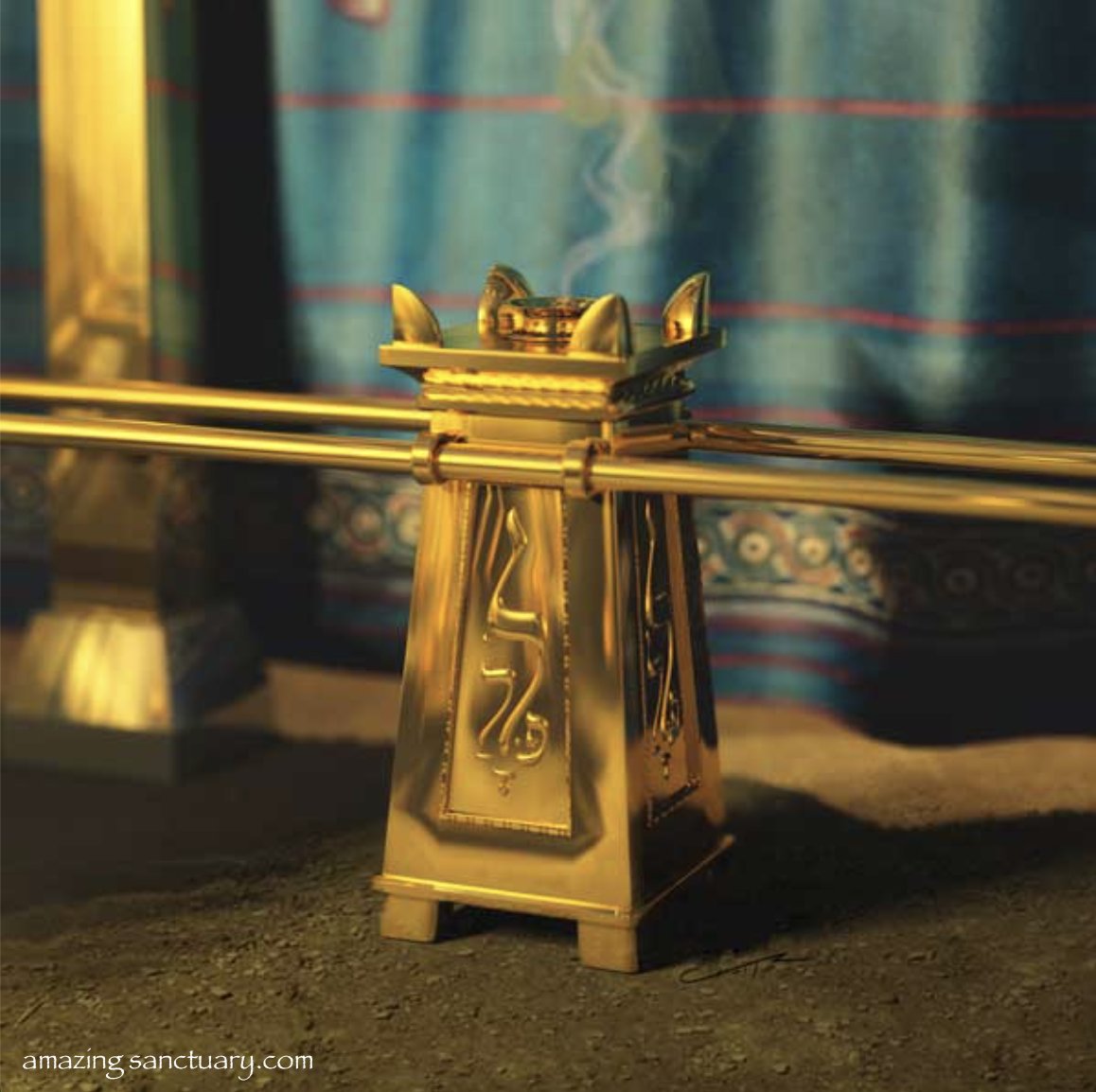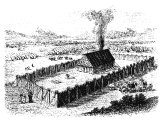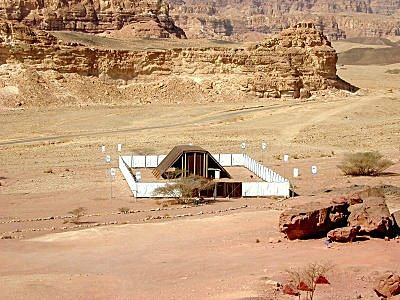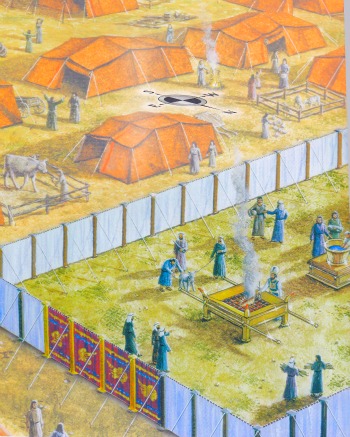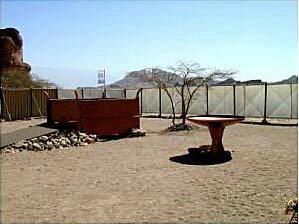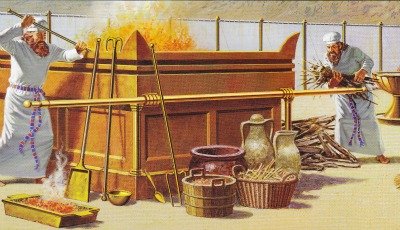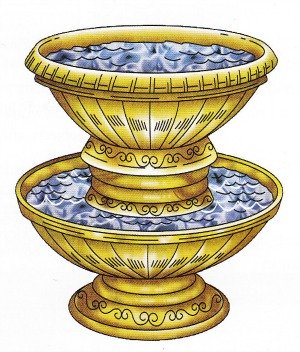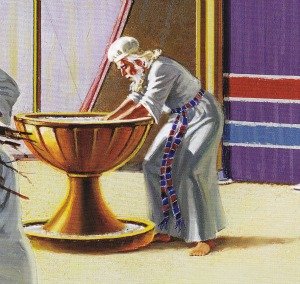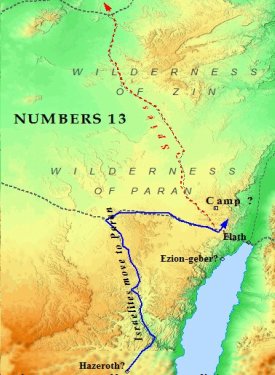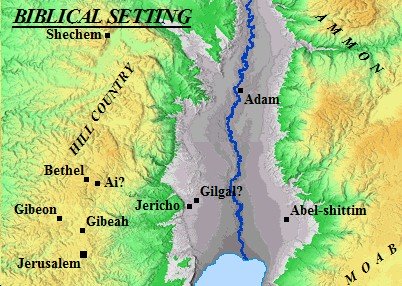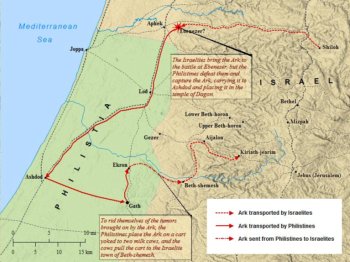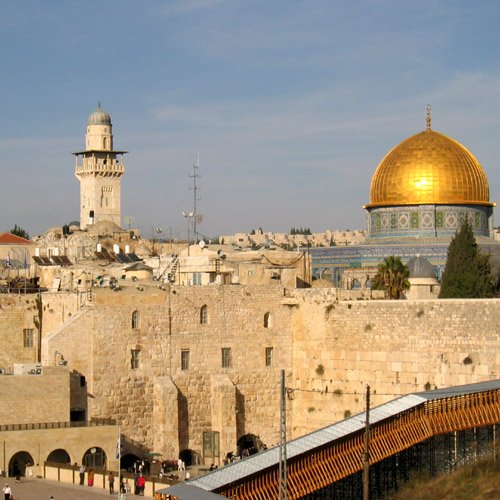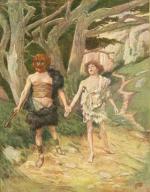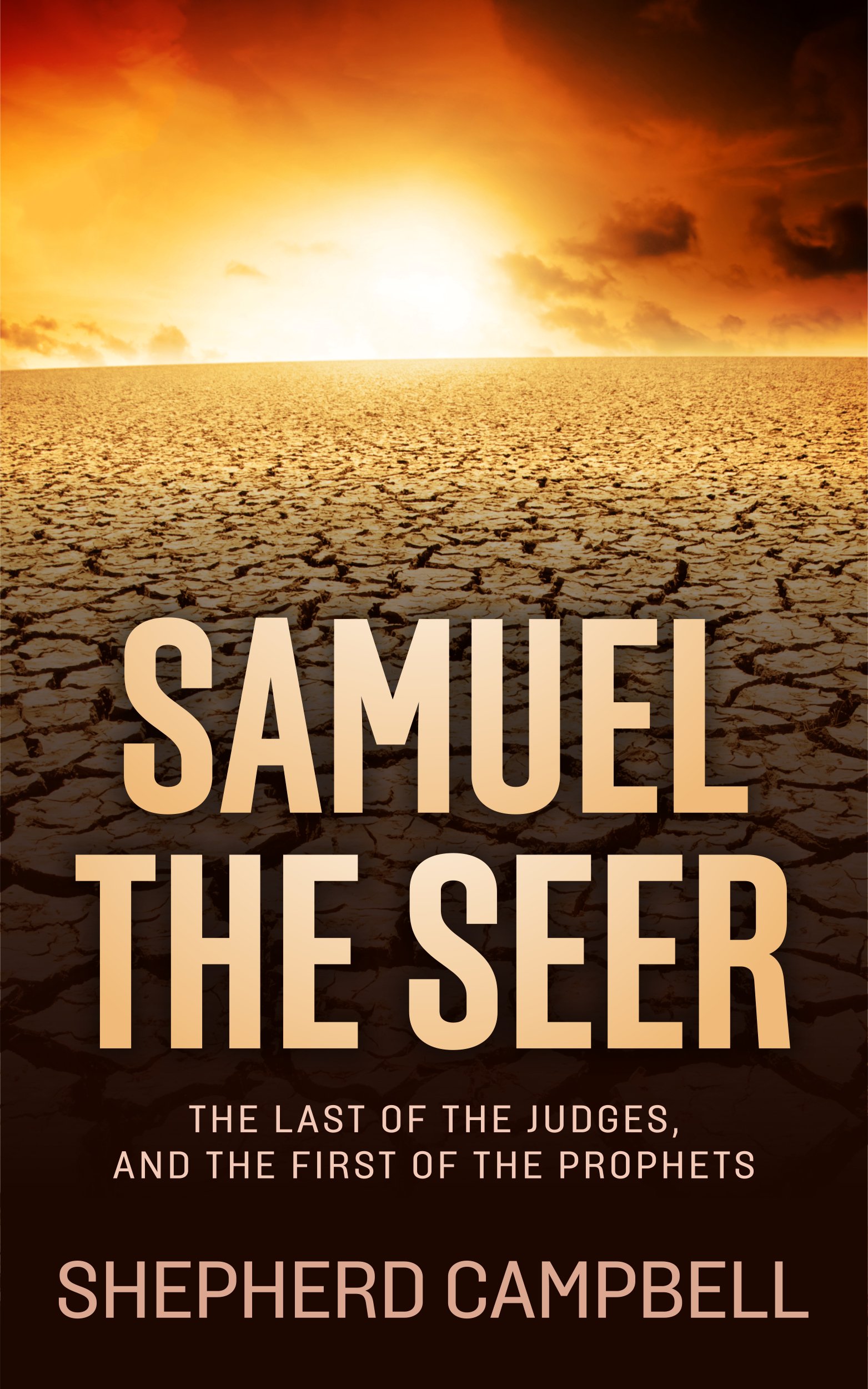- Biblical Maps
- Home Page
- History of Israel Blog
- Ancient Mesopotamia
- Map of Palestine
- Abraham
- Ancient Israel
- 12 Tribes of Israel
- Jerusalem
- The Book of Isaiah
- Palestine
- The Habiru
- Contact Us
- Bible Study Forums
- Media Page
- Visitors Sitemap
- Privacy Policy
- The History of the Old Testament
- In the Days of Noah
- The City of Jericho
VISIT OUR FACEBOOK PAGE!
The Tabernacle of Moses
The tabernacle of Moses dominates the latter half of the Old Testament book of Exodus, one of the earliest and oldest narratives of ancient Israel. At the end of Genesis Jacob takes his family and moves to Egypt, where his son Joseph is second-in-command answering only to Pharaoh himself. However, over time the Israelites fall out of favor and in Exodus 1:8 we are told, "Now a new king arose over Egypt, who did not know Joseph.".
Thus the ancient Hebrews living in Egypt became enslaved by Pharaoh. It is during this period that Moses is born in Exodus 2. Exodus 2 - 11 describes the conflict between Pharaoh and the enslaved Hebrews. This conflict culminates in the Ten Plagues of Egypt, a cosmic showdown between Pharaoh and God with Moses and his brother, Aaron, functioning as God's mouthpiece and representatives before Pharaoh. After the 10th Plague - the Death of the Firstborn Son - Pharaoh relinquishes and Moses leads the enslaved Israelites out of Egypt.
Pursued by the Egyptian army, Moses leads his people into the wilderness, miraculously crossing the Red Sea (more likely the Sea of Reeds), and leaving the Egyptians to perish by the mighty hand of Yahweh Elohim as the waves of the parted Sea crashed down upon them, swallowing the entire Egyptian army alive and burying them deep under the waves.
|
THE 12 TRIBES OF ISRAEL ENCAMPED AROUND THE TABERNACLE OF MOSES |
The dating of the Exodus and the building of the tabernacle of Moses, like many Biblical dates, is a highly controversial and much debated topic amongst Biblical scholars and archaeologists. For our current purpose it is enough to over simplify the debate, and simply state that two primary lines of thought exist. One is referred to as the High Date, or earliest date, and the other as the Low Date, or later date. |
|
The High Date of the birth of Moses is in 1525 B.C. and the Low Date 1369 B.C. (Rose Guide to the Tabernacle, 10). Thus the Exodus took place in either 1446 B.C., or 156 years later in 1290 B.C. - depending on one's viewpoint. Following the same line of thought, the episode with Moses and the tablets at Mount Sinai likely took place in either 1446-1445 B.C. (High Date), or 1290-1289 B.C. (Low Date).The Rose Guide to the Tabernacle suggests the date of 1440 B.C. as the year of the construction of the tabernacle of Moses. Most in the world of Biblical academia prefer the Low Date of the 13th century BC. Further study is suggested to obtain a better understanding of the arguments in favor of and against each date. It is at this point the tabernacle of Moses begins to play a central role in the life of ancient Israel, and remains a central element of Israelite religion and culture to this very day. |
The Exodus Tabernacle was built in the wilderness. It was YHWH Elohim's sanctuary, and He descended upon it in the Cloud. The Cloud led and protected Israel as it was the presence of God. And the presence of God dwelt in the Tabernacle. The Tabernacle was the focal point of ancient Hebrew culture until Solomon built the First Temple in Jerusalem ca. 960 BC.
But what is the tabernacle of Moses? What, exactly, was its
function? How did the Exodus Tabernacle house God? How did it lead
Israel? The tabernacle of Moses is a fascinating piece of Israelite history, and a beautiful example of God's presence amongst His people.
THE TABERNACLE OF MOSES
PAGE CONTENTS
Coverings of the Tabernacle of Moses
The Courtyard & Its Sacred Objects
The Tabernacle of Moses
Exodus 25:1 - 40:38 reveals God's instructions to Moses for building a tabernacle, or tent, dwelling, etc. The Tabernacle would be the place for God's presence to occupy as He came down to dwell amongst His people in the wilderness. This word, "tabernacle", literally translates as "a dwelling place". In its original form in Exodus it is a tent. It was to be God's dwelling place among Israel in the wilderness. These verses are very repetitive in describing, in great detail, the materials and construction of the Exodus Tabernacle. It was to be essential in the relationship between God and Israel, and the primary focus of their wilderness experience.
God's command to Moses is found in Exodus 25:8-9.
"And let them construct a sanctuary for Me, that I may dwell among them. According to all that I am going to show you, as the pattern of the tabernacle and the pattern of all its furniture, just so you shall construct."
Two related words are discussed in verses 8 and 9 - "sanctuary" and "tabernacle". What becomes evident as one studies the tabernacle is there are two primary objects/structures involved; the ark of the covenant, and the tent it is housed in. Thus when discussing the tabernacle of Moses it is important to keep in mind that the ark of the covenant is where God's presence dwells; and this ark is housed in a tent, which is the dwelling place, or tabernacle for God, which itself is constructed inside of a fenced-in compound.
In Exodus 25:8 God instructs Moses to build Him a "sanctuary". The Hebrew word used in this instance is Miqdash or Miqqedash. This word translates as, a consecrated thing or place; a palace or sanctuary; a holy place; chapel; asylum. Interestingly the word is used to denote both a sanctuary devoted to God Almighty as well as idols and pagan gods. Thus the word was already in use when God commanded Moses to build Him a sanctuary. Moses would have understood, perhaps based on temples and sanctuaries in Egypt, what God intended.
The word is also used in Exodus 15:17. In the NASB this chapter is titled, The Song of Moses and Israel
"Thou wilt bring them and plant them in the mountain of Thine inheritance, the place, O Lord, which Thou hast made for Thy dwelling. The sanctuary, O Lord, which Thy hands have established."
We can deduct that God wanted Moses to build Him a holy sanctuary, a holy dwelling place where He could dwell among His people on earth. This sanctuary was also to be a consecrated place, set apart for God's residence. Exodus 25:9 lends further insight, using the word "tabernacle". The Hebrew used in this verse is Mishkan.
Mishkan means a residence, including a shepherd's hut, an animal's lair, or figuratively speaking, the grave. It is also used in reference to the wooden walls of the tabernacle of Moses, and is used to denote the later Temple in Jerusalem.
Mishkan is derived from the Hebrew word Shakan, which means to reside, or permanently stay. Shakan has also been translated as, abide; continue; dwell; have habitation; inhabit; lay; place; remain; rest.
It seems clear that God wants Moses to build Him a sacred and holy place where He may live with His people here on earth. God would dwell among His people, leading them and protecting them. He would have habitation within Israel's camp, in fact at the very center of Israel's camp, symbolic of Him being in the center of their hearts. This was in accordance with ancient practices, for the king of a particular army always encamped in the center of the camp. The ark of the covenant was to be His home, kept inside a sacred tent.
The tabernacle of Moses was, in its simplest terms, God's House among His people.
Plan for the Tabernacle of Moses
The tabernacle of Moses was birthed at Mount Sinai when Moses met face to face with God. However, in order to show the Israelites He was no local god of the Sinai desert, God Almighty stationed Himself in what Nahum M. Sarna describes as a "mobile sanctuary" (Ancient Israel, 46). He would travel with, in fact lead, Israel through the desert and into the Promised Land. God was not to be confined to one area or locality. He was a universal God, and as such would travel and lead His people.
John Bright called this tabernacle a "tent-shrine of desert origin" (A History of Israel, 146). Bright compares this shrine to other ancient amphictyonies, such as was commone with the Greeks and their Oracle at Delphi. Other scholars have pointed out similar ritual structures used by the ancient Romans as well. Israel was to be a people on the move, thus their temple had to be mobile. God was leading them out of Egypt and into the wilderness, on their way to a land He had promised them through His servant Abraham hundreds of years earlier.
Bright talks in-depth of other portable tent-shrines in his book. In this respect, the narrative concerning the construction and nature of the Tabernacle of Moses does reflect ancient reality, so argues Bright against critics of the narrative. Egyptian, Ugaritic, Islamic and even pre-Islamic traditions all speak of such mobile sanctuaries to Allah or a particular god. Archaeologists also discovered a Midianite tent-shrine at Timna, north of modern day Eilat. The narrative rings true when compared to other ancient cultures and their respective shrines and temples.
It becomes clear a key material used in the tabernacle of Moses was acacia wood. This makes clear sense when one takes into account acacia grows abundantly in the relatively barren wilderness of Sinai. Acacia wood was used on the tent itself, as well as the Ark of the Covenant, and on many of the sacred objects found within the tabernacle of Moses. It would have been an abundant and easily accessible resource given the Israelite location at Mt. Sinai and the surrounding terrain.
Construction begins in Exodus 25:1-7 with the gathering of the materials. God instructs Moses to gather gold, silver and bronze from among the Israelites. Not only were they to gather these precious materials, but also much, much more. Items such as blue, scarlet and purple "material, fine linen" and other fine articles. Oil, spices, incense, stones and wood were also gathered together.
The natural question thus arises; Where did the Israelites obtain such expensive and luxurious items? The construction calls for a wealth of material, fine cloths, stones and wood, gold, silver and bronze. How would a wandering band of refugees fleeing through the wilderness have such materials? Where would they store and carry such items? How would they use them to construct an object/structure?
Critics are quick to point to these questions as examples of the fallacy of the account in the Bible. Some critics claim the tabernacle of Moses was devised merely to provide a historical tradition for the temple in Jerusalem. However, a rebuttal to this argument lies within the Biblical account. An interesting ancient tradition is preserved in Exodus 12:33-36. In verse 33 the Egyptians "urged the people, to send them out of the land", panicked by the plagues God had sent upon the land, people and livestock of Egypt.
Exodus 12:35-36 records a fascinating episode in the Israelite departure.
"Now the sons of Israel had done according to the word of Moses, for they had requested from the Egyptians articles of silver and articles of gold, and clothing; and the Lord had given the people favor in the sight of the Egyptians, so they let them have their request. Thus they plundered the Egyptians."
In his Hebrew-Greek Key Study Bible (NASB), Spiros Zodhiates states; "The Revised Version correctly translates 'They asked of the Egyptians...' It was not regarded as a loan. It was customary at the parting of friends or leaving of a servant to give a gift." He further asserts the fact that Israel had long been servants of the Egyptians, and it was likely that in a state of panic the Egyptians willingly gave them anything they wanted just to leave. It is an interesting theory, and one that does fit into the Biblical passage. Thus the Israelites plundered the Egyptians without every lifitng a sword against them. When they left Egypt with their freedom, they also parted with an abundant supply of gold, silver, bronze, and other valuable metals and goods!
This would, of course, account for the materials Moses instructed
the tribes to gather together. God, in His supreme wisdom, accounted for every detail of the Israelite Exodus! Using these materials they would
construct a tabernacle for God. Not only would the Egyptians have
provided the materials used, but also, perhaps, the blueprints for
different structures and objects within the Tabernacle. For example, and
discussed more in-depth below, wooden arks of similar design and shape
as the Ark of the Covenant have been found from ancient Egypt. King
Tut's tomb was discovered with an ark of the god Anubis.
Scholars point to this as credible evidence Moses would have had an idea of the structures God wanted him to build within the tabernacle of Moses. It was not as unfamiliar a concept to Moses or the Israelites, perhaps, as previously thought. It has already been pointed out that portable tent-shrines were common in other ancient cultures. Sacred arks and chests appear to have been in common use among the Egyptians as well.
In short, the tabernacle of Moses was composed of three parts, the Courtyard, the Holy Place, and the Most Holy Place (Holy of Holies) which housed the Ark of the Covenant. Sacred objects were found within the courtyard, which was enclosed with a 7.5 foot, screened, wooden-post fence. Though the courtyard interior could not be viewed from the outside due to the fence, the upper-half of the tabernacle structure itself would have been visible stretching above the top of the surrounding fence as it was taller than the fence itself by 7.5 feet.
The people of Israel were unable to see inside the fenced-in compound unless they were standing at the tabernacle's gate located at its eastern end, though the top half of the tabernacle would have been visible. They could see only a portion of where God rested from the outside - but enough to know that God was with them.
The common unit of measurement used in the Old Testament account is the cubit. A cubit equals approximately 18 inches, 1 1/2 feet, or 46 centimeters. This is the unit of measurement given for the Tabernacle and the surrounding compound in Exodus. Exodus 26:10 indicates that God ordered Moses to build the tabernacle "according to its plan which you have been shown in the mountain."
The courtyard was surrounded, as stated earlier, by a fence 7.5 feet high, 100 cubits (150 ft. or 46 meters) long and 50 cubits (75 ft. or 23 meters) wide. This outer fence enclosed the Tabernacle Courtyard, its sacred objects, and the actual tent/Tabernacle. The courtyard was entered through a gate in the fence, located on the eastern end of the tabernacle compound. Opposite the gate, on the western end, stood the tent.
Between the gate and the tent were the Courtyard's sacred objects. Upon entering the eastern gate one would first have encountered the Bronze Altar, upon which the animal sacrifices were made by the priests. Further in was the Bronze Laver, standing outside of the tent's entrance. Further description will be given below.
Exodus 27:9-18 gives the dimensions of the court. Verse 9 indicates the south side of the Court of the Tabernacle would consist of "hangings for the court of fine twisted linen one hundred cubits long for one side;". The fine twisted linen provided the screening for the fence. Thus the south side of the Court was 100 cubits, or 150 feet long.
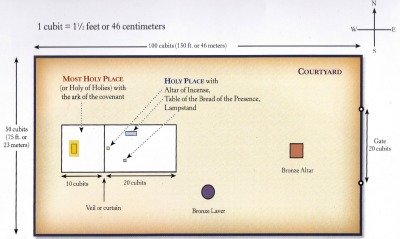 The interior of the compound contained certain sacred objects used by the Israelites for sacrifices.
The interior of the compound contained certain sacred objects used by the Israelites for sacrifices.The same holds true for the northern side of the tabernacle of Moses. Verse eleven of chapter 27 in Exodus describes the northern side as being one-hundred cubits in length, or 150 feet. The fence along the north and south sides were constructed of twenty pillars on each side, with twenty sockets of bronze and silver hooks and bands along each pillar. It was upon these hooks and bands fastened to each pillar that the screen of fine twisted linen was hung, thus forming the screened-in fence.
Exodus 27:12 gives the dimensions of the western side of the Tabernacle compound.
"And for the width of the court on the west side shall be hangings of fifty cubits with their ten pillars and their ten sockets."
The eastern side's dimensions, which housed the gate leading into the tabernacle of Moses, is given as fifty cubits as well in verse 13. Fifty cubits equals 75 feet. Thus we gather the entire compound stood at 150 feet long on the northern and southern sides, and 75 feet wide at the western and eastern ends. Whereas twenty pillars were used on the north and south sides, only ten pillars were used to form the western fence and eastern gate.
Within the courtyard was the Tabernacle structure, a tent-like structure in the form of a nomad's tent 45 feet long, 15 feet wide and wooden walls fifteen feet high, covered with multiple layers of various material and supported by boards fifteen feet in height and poles. The precise nature of the Tabernacle and how it looked has been lost, however replicas have been built with some differing slightly from others. As stated above, this structure was located in the rear of the courtyard, on the western end of the compound. Approximately 37.5 feet separated the walls of the Tabernacle structure/tent from the screened fence along the north and south walls of the Tabernacle compound.
Exodus 26:1-36 depicts the Tabernacle as a single, undivided room. In verses 31-37 the Tabernacle is turned into two rooms by the veil. The first room was the Holy Place, 30 feet long and composed of sacred objects along each of the two side walls. The Holy Place terminated at the veil, separating another room from sight.
This inner room was the Most Holy Place, fifteen feet long, fifteen feet wide and fifteen feet high. The Ark of the Covenant was housed inside the Most Holy Place. It is suggested in the Bible that manna and Aaron's rod were also in the Most Holy Place, though perhaps not in the Ark but resting before it. This was the very heart of the entire tabernacle compound, in fact, the very heart of the entire Israelite camp. This was where God's presence rested - upon the Mercy Seat of the Ark within the Holy of Holies.
Thus the Tabernacle is used to both refer to the actual structure, composed of the Holy Place and the Most Holy Place, and then at other times to the entire compound itself, including the fence, gate and courtyard, as well as the various sacred objects in both the courtyard and within the tent - including the Ark of the Covenant.
Names of the Tabernacle of Moses
The tabernacle of Moses goes by many names throughout the Old Testament narrative. The first name given is in Exodus 25:8, discussed above. In this verse the tabernacle of Moses is referred to as a sanctuary. In verse nine God tells Moses He is going to show him how to build the tabernacle and all its furnishings. As we will soon see, the tabernacle consisted of holy furniture, or the sacred objects.
Throughout Exodus 26 the word used is tabernacle. Exodus 26 describes the building of the structure which would house the Ark of the Covenant. In Exodus 26:36 it is described as a tent. God commands Moses to "make a screen for the doorway of the tent". This reflects both the physical appearance and mobile nature of the tabernacle of Moses.
Exodus 27:21 packs a lot of description into one verse concerning this structure and its function and nature.
"in the tent of meeting, outside the veil which is before the testimony, Aaron and his sons shall keep it in order from evening to morning before the Lord..."
The tabernacle is referred to as the tent of meeting. The tent of meeting is distinctly defined as the interior of the portable tent or tabernacle. It was here, specifically in the Holy of Holies, that God would meet with Moses, thus the name the tent of meetings. Outside of the veil is where only Aaron and his sons may enter and work. Inside the veil rested the Ark of the Covenant, where only the High Priest could enter once a year to meet with God. These two separate and holy areas comprised the tent of meeting.
Interestingly the Ark of the Covenant is also called the testimony. As will be discussed later, inside the Ark of the Covenant were the holy tablets containing the Ten Commandments. Whether the manna and Aaron's staff were inside of the Ark, or outside lying before it, is a matter of interpretation. Verses throughout Scripture suggest both. Thus the Ark was also called the testimony at times. It stood as a testament of God's promise and presence in Israel and with the people. The tablets were God's testament, or testimony, to Moses and His people as to how they should structure and live their lives.
Exodus 33:7 uses the term tent to describe the Tabernacle of Moses. In Exodus 38:21 a combination of words are used. Verse twenty-one refers to the tabernacle and the tabernacle of the testimony. This designation is used again in Numbers 1:50. In both passages side-notes highlight the fact that tabernacle literally means dwelling place.
Exodus 40:34 calls it the tent of meeting and tabernacle. Numbers 17:7-8 uses the phrase tent of meeting in both verses to designate the tabernacle of Moses.
Numbers 9:15 depicts a fascinating event and uses multiple names in referencing the tabernacle of Moses. The Israelites are well into their sojourn in the wilderness, following God's presence manifested in the cloud which hovered in their midst when this verse takes place. Notice the different names used.
"Now on the day that the tabernacle was erected the cloud covered the tabernacle, the tent of the testimony, and in the evening it was like the appearance of fire over the tabernacle until morning."
As we get closer to the time of David and Solomon the phrase temple of the Lord appears. I Samuel 3:3 states Samuel was lying down "in the temple of the Lord where the ark of God was". Psalm 15 asks the question who shall dwell in God's Tent. Thus one can deduct that many terms and names are used to designate the tabernacle of Moses constructed in Exodus. They all refer to the same mobile and portable tent-shrine, the tabernacle which housed the Ark of Covenant, which housed God's presence.
The Ark of the Covenant
Exodus 25:19-22
The Biblical description of the tabernacle of Moses begins with the innermost parts and works it way outward, meaning the Ark and the sacred objects are built first, followed by the actual structure built last. The Ark of the Covenant was to be placed inside the Holy of Holies, or the Most Holy Place. As discussed above, this was a 15' x 15' x 15' room inside the Tabernacle tent, separated from the Holy Place by a veil. It was the innermost room of the Tabernacle.
Exodus 25:10-22 describes the dimensions and construction of the Ark of the Covenant and its Mercy Seat. In verse ten God tells Moses to build "an ark of acacia wood".
The ark was to be 2.5 cubits long, 1.5 cubits wide and 1.5 cubits high. These dimensions equate to a box 3'9" long by 2'3" wide and 2'3" deep. It was constructed of wood and overlaid with a sheet of gold inside and out, and a gold molding or crowning around the bottom of it. On each side of the Ark were two golden rings fastened to it. It would be the central focus of the tabernacle of Moses.
Through these rings wooden poles, also overlaid with gold, were slid into in order to carry the Ark of the Covenant without actually touching it. God explicitly states that these poles should never be removed from the golden rings. He also states that the Ark is not to be touched by man. Future violations of this command are recorded in the Bible with the victims (some even Hebrews) dying as a result.
Interestingly enough arks were common objects to the ancient Egyptians. Thus Moses would have had a precise idea of what God had wanted him to build based on his Egyptian experience. For instance, when King Tut's tomb was discovered many articles and objects were also discovered within the tomb. One such object was the Anubis Chest.
The Anubis Chest was found guarding the entrance of Tut's treasury. It functioned as a shrine to Anubis, the Jackal-god of mummification and the underworld. It was constructed of wood, 46.54 inches tall (3.87 feet), 106.29 inches long (8.85 feet) and 20.47 inches in width (1.7 feet). The inside of Anubis' ears and collar were of gold leaf, with eyes inlaid of calcite and obsidian set into gold, and its nails were silver.
As the two cherubim upon the mercy seat of the Ark also functioned as a lid, so does the Anubis figure on the Anubis Chest. It was a covering, or lid, similar to that of Israel's Ark. Also like the Ark of the Covenant, the Anubis Chest was carried by poles running along its side. Moses would have know exactly what God wanted with His Ark of the Covenant based on similar Egyptian objects and arks which he had previously seen while living in Pharaoh's household.
Inside of the Ark of the Covenant were the tablets God had given Moses. Exodus 25:16 seems to indicate God is giving Moses the plans for the Tabernacle before He has given Moses the commandments.
"And you shall put into the ark the testimony which I shall give you."
The other contents of the Ark of the Testimony depend on one's interpretation of the context. It should be noted the two tablets are the only objects specifically mentioned as residing inside of the Ark. I Kings 8:9 mentions there was nothing else in the Ark, save the stone tablets.
"There was nothing in the ark save the two tablets of stone, which Moses put there at Horeb, when the LORD made a covenant with the children of Israel, when they came out of the land of Egypt."
However, in the New Testament Paul has a different take on what lay inside the Ark. It should be noted, though, that the Ark of the Covenant had been missing from Israel for an unknown but lengthy period by the time of Paul. In the Old Testament no references are made to it after the Babylonian destruction of Jerusalem and the Temple during the time of the prophet Jeremiah, ca 586 BC. It simply vanishes into history, and has not been seen since. Hebrews 9:3-5 depicts Paul's opinion on the matter.
"And after the second veil, the Tabernacle which is called the Holiest of all; Which had the golden censer, and the Ark of the Covenant overlaid round about with gold, wherein was the golden pot that had manna, and Aaron's rod that budded, and the tablets of the Covenant; And over it the cherubims of glory shadowing the Mercy seat; of which we cannot now speak particularly."
It is, of course, possible that at a later date after Moses the manna and Aaron's rod were placed inside the Ark of the Covenant, though this is unlikely. However, there are verses which indicate that some objects likely rested before the Ark of the Covenant, if not inside of it. These objects definitely were located inside the Most Holy Place with the Ark of the Covenant. Exodus 16:33-34 is one of these verses.
"And Moses said unto Aaron, Take a pot, and put an omer full of manna therein, and lay it up before the LORD, to be kept for your generations. As the LORD commanded Moses, so Aaron laid it up before the Testimony, to be kept."
As stated above, "the Testimony" was another description of the Ark.
Another example is provided in Numbers 17:10-11.
"And the LORD said unto Moses, Bring Aaron's rod again before the Testimony, to be kept for a token against the rebels; and thou shalt quite take away their murmurings from me, that they die not. And Moses did so: as the LORD commanded him, so did he."
Thus Scripture indicates that both manna and Aaron's rod were located within the Holy of Holies, perhaps lying on the ground before the Ark of the Covenant, inside of which were the two stone tablets of the testimony of God to Moses on Mt. Sinai. On top of the ark was the Mercy Seat, where God's presence in the tabernacle of Moses rested.
Moses met with God face to face, and seemingly more than once a year, quite likely on a daily basis though we will never know how often God and Moses met and talked. Moses, however, was an exceptional man. After the time of Moses, the High Priest was only allowed to enter the Holy of Holies once a year. Once a year the High Priest would stand before the Ark of the Covenant and sprinkle blood on the Mercy Seat as a confession of the sins of the people and to atone for Israel's sins. The relationship between God and His people would be restored, and the High Priest would either emerge as a sign of forgiveness, or die inside as a sign of God's anger.
The Mercy Seat
The Ark of the Covenant was a special and mysterious object within the tabernacle of Moses. It has captured the imagination of people since antiquity, even into the modern era. Its powers are evident throughout Scripture, as the Israelites would often carry it into battle. The Ark was basically composed of two parts; the actual wooden chest overlaid with gold and containing the tablets, and the mercy seat which served as the Ark's covering and lid. The mercy seat was God's Throne among His people. It was where the presence of God dwelt. It was to be made of one solid piece of gold and hammered into shape. God lays forth precise instructions to Moses concerning the mercy seat in Exodus 25:17-22.
Verse seventeen introduces the mercy seat.
"And you shall make a mercy seat of pure gold, two and a half cubits long and one a half cubits wide."
The mercy seat was to be an especially significant object, for it is where the presence of God would rest and lead Israel. God's actual presence rested on top of the Ark, on its lid, or the mercy seat as will be seen. Scripture tells us two objects adorned the mercy seat, which to this day scholars are not absolutely certain what these objects looked like though the Bible does give some description.
God instructed Moses to construct two golden cherubim to place on each end of the mercy seat in Exodus 25:18.
"And you shall make two cherubim of gold, make them of hammered work at the two ends of the mercy seat."
Verse nineteen specifically mentions that the entire mercy seat, including the cherubim, were to be "of one piece" of gold, thus it required a great deal of skill. The cherubim were to be facing each other, with their winds spread out before them. Verse twenty describes their wings as being "spread upward, covering the mercy seat with their wings and facing each other".
Exodus 25:22 depicts the function of the mercy seat and significance of the Ark of the Covenant.
"And there I will meet with you; and from above the mercy seat, from between the two cherubim which are upon the ark of the testimony, I will speak to you about all that I will give you in commandment for the sons of Israel."
The Mercy Seat was God's Throne on earth. The tabernacle of Moses would not be complete without it. The cherubim functioned to serve as symbols of God's divine throne in Heaven. God wanted Israel to see Him enthroned as their King, thus the Mercy Seat was His Kingly Throne amidst their camp. As their king, God would set His Throne at the very center of Israel's camp. This was common practice, as touched upon earlier, by ancient Near Eastern kings. In I Samuel we see king Saul encamped in the middle of Israel's camp numerous times. Kings would establish their tent at the center of their army's encampment, just as God does with His Throne and the tabernacle of Moses.
Indeed the cloud by day and pillar of fire by night, which was God's presence made manifest, led Israel. It's point of origin was the Mercy Seat atop the Ark. The final verses in Exodus describe this cloud and its function. Excerpts from Exodus 40:34-38 are given below.
"Then the cloud covered the tent of meeting, and the glory of the Lord filled the Tabernacle ... And throughout all their journeys whenever the cloud was taken up from over the tabernacle, the sons of Israel would set out; but if the cloud was not taken up, then they did not set out until the day when it was taken up ... the cloud of the Lord was on the tabernacle by day, and there was fire in it by night..."
The Holy Place
As one entered the Tabernacle of Moses from the outside compound the Holy Place was the first room encountered. Priests were required to be ritually pure upon entering the Holy Place, thus the Bronze Laver (to be discussed below) was used outside before entering the Holy Place. This area was holy because of its proximity to the Ark of the Covenant and God's presence. God separated this area as well for special rituals and sacrifices the priests were to make.
At the time of the construction of the tabernacle of Moses only Aaron and his sons were allowed to enter and serve in the Holy Place. Exodus 27:21 records these instructions.
"In the tent of meeting, outside the veil which is before the testimony, Aaron and his sons shall keep it in order from evening to morning before the Lord; it shall be a perpetual statute throughout their generations for the sons of Israel."
Aaron and his sons, however, were not permitted to enter inside the veil. Notice the Bible only says "outside the veil which is before the testimony". The Ark is again referred to as the testimony. Remember that only the High Priest could enter the Most Holy Place, inside the veil before the Ark and the Mercy Seat, which housed God's presence. The High Priest of the tabernacle of Moses, at this time, was Moses himself. Only he entered the Most Holy Place.
Nonetheless, this was a special service set apart for Aaron and his descendants. The Holy Place was separated from the hustle and bustle of the outside compound where animal sacrifices took place on behalf of the people. One may safely assume that inside the Holy Place things were very quiet and solemn, illuminated by the soft glow of candle light bouncing off gold, filled with the sweet smell of burning incense. It would have been a very different scene from the busy work of the priests, the constant sacrifices and the noisy bleating of the animals outside.
Inside the Holy Place were three sacred objects, each with a specific purpose and function. These three pieces of sacred furniture were the Table of Showbread, the Golden Lampstand, or Menorah, and the Altar of Incense. After the Ark's description, the Bible gives the description of the Table of Showbread.
The Table of Showbread
God gives Moses the instructions concerning the Table of Showbread in Exodus 25:23.
"And you shall make a table of acacia wood, two cubits long and one cubit wide and one and a half cubits high."
These dimensions equate to a table 36 inches (3') long, 18 inches (1'6") wide and 27 inches (2'3") high. Like the Ark it was to be made of acacia wood and overlaid with gold. This meant sheets of gold were hammered flat and then placed, perhaps by nail or some other method, over the wood. It was a thin covering of gold, pure gold. God also instructed Moses to "make a gold border around it".
Also like the Ark of the Covenant, the Table of Showbread possessed four gold rings set at the corner of each joint where the legs connected to the table top. Wooden poles, also overlaid with gold, were slid through the rings and used to carry the Table exactly like the Ark was transported. God also instructs Moses to make all of "its dishes and its pans and its jars and its bowls" of pure gold.
The Table of Showbread was assigned a place along the north wall of the tent of meeting. Thus as one entered the Holy Place from the Tabernacle Courtyard, the veil would be seen in front constructing the western wall of the Holy Place, separating the Holy Place from the Most Holy Place. On the right hand side, along the northern wall outside the veil rested the Table of Showbread. These instructions were given in Exodus 40:22.
"Then he put the table in the tent of meeting, on the north side of the tabernacle, outside the veil."
This verse gives a specific location assigned to the Table of Showbread. God also gave specific instructions to Moses on how to utilize the Table and what was to go on it. These instructions are given in Leviticus 24:5-9. The book of Leviticus is dedicated to the specific commandments and instructions God gave Moses regarding every facet of Israelite life and religion. Verses five and six begins God's command to Moses.
"Then you shall take fine flour and bake twelve cakes with it; two-tenths of an ephah shall be in each cake. And you shall set them in two rows, six to a row, on the pure gold table before the Lord."
These twelve loaves represented the twelve tribes of Israel. Bread was a common metaphor throughout the Old Testament, as well as in the New Testament. It represented life, and God was the Giver of Life. In the New Testament, the disciples broke bread with Jesus during the Last supper. The bread in that instance represented the life of Jesus Christ, the Life-Giver to all of mankind, Gentiles included.
Thus the bread on the Table of Showbread represented God's provision for Israel, both through the manna in the wilderness and as God Almighty, Creator and Giver of life. The tabernacle of Moses was a reflection of God's grace and love towards mankind in every way. Not only was the bread a symbol of God's provision, but it stood as a reminder of His covenant with Israel.
In ancient times, covenants were sealed with a meal. In Exodus 24:11 the "nobles of the sons of Israel" affirm their relationship with God by eating and drinking. Similarly, Abraham and the mysterious Melchizedek king of Salem shared a meal in the valley of Shaveh in Genesis 14:18. So would God share this meal with His people in the tabernacle of Moses.
Further description is given to the Table of Showbread in Numbers 4:7.
"Over the table of the bread of the Presence they shall also spread a cloth of blue and put on it the dishes and the pans and the sacrificial bowls and jars for the libation, and the continual bread shall be on it."
This passage describes the duties of the Kohathites, of the sons of Levi. Notice the table is called the "table of the bread of the Presence". The Presence was, of course, God Himself. His presence dwelt and empowered the tabernacle of Moses. Every Sabbath day the bread was replaced by new loaves. Aaron and his sons would then eat the old loaves. The bread was reserved for them only.
In eating of the bread of the Presence, Aaron and his sons were renewing their covenant with God through the covenant meal. It served them, as well as all of Israel, as a reminder of the Covenant God entered into with them at Mt. Sinai. Centuries later, Jesus would eat with His disciples, telling them the bread would later serve as a reminder for His body and sacrifice for us.
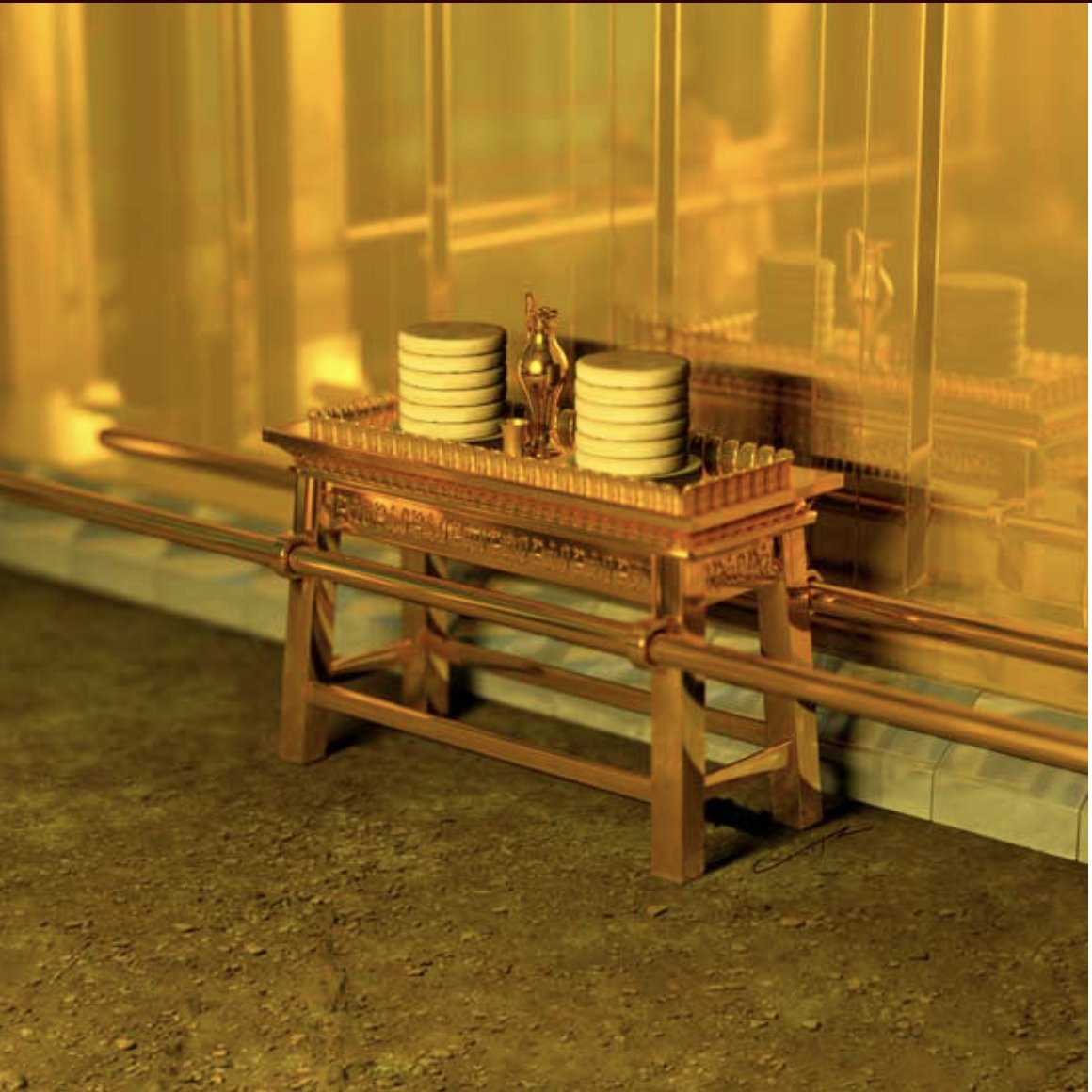 Exodus 25:30 - “And you shall set the bread of the 1Presence on the table before Me continually."
Exodus 25:30 - “And you shall set the bread of the 1Presence on the table before Me continually."Paul, too, writes of this bread in Hebrews 9:2. Paul was writing in the first century AD. The tabernacle had been replaced by the Temple in Jerusalem. The table of the Showbread would have stood in the Holy Place of Herod's Second Temple. However, the tabernacle of Moses contained the Ark of the Covenant, God's Presence. Herod's Temple did not, for the ark had lost since vanished from Israel. Mere decades after Paul, in 70 AD, the Temple, too, would vanish from Israel as Rome burned it to the ground.
"For there was a tabernacle prepared, the outer one, in which were the lampstand and the table of the sacred bread; this is called the holy place."
Paul makes a fascinating comparison between the old Tabernacle and the new, represented in the life, death and resurrection of Jesus Christ. The literal Greek calls the bread, "the bread of presentation".
It is fascinating when one takes the bread on the Table of Showbread in the tabernacle of Moses, understands its function as both a reminder of God's provision and covenant, and then sees this notion carried over into the New Testament as well. Every Hebrew living in Jerusalem would have noticed the symbolism when Jesus spoke the words of John 6:35.
"Jesus said to them, 'I am the bread of life; he who comes to Me shall not hunger, and he who believes in Me shall never thirst.'"
First-century AD Israelites would have likely associated the bread of life with the bread on the Table of the Showbread in the Temple. Christians should understand their roots were born in Judaism. The two are not only related, but brothers. After all, Jesus Christ as a man on earth was a Jew.
The Golden Lampstand
Exodus 25:31-40 describes the Golden Lampstand, which provided light for the priests as they worked in the Holy Place. As the Table of Showbread was located along the northern wall of the tabernacle of Moses, the Golden Lampstand stood along the southern wall, on the left-hand side as one entered the tent. The lampstand's exact shape is unknown.
The dimensions, too, are unknown, although Jewish tradition claims it was about 5 feet high, 3'6" wide. Many pictures depict the Golden Lampstand in the form of a menorah with three shafts protruding from each side. This is a common depiction, though only one of a number of different possibilities.
The Bible does give certain characteristics, however. Exodus 25:31,39 lends special insight into this exquisite work of art.
"Then you shall make a lampstand of pure gold. The lampstand and its base and its shaft are to be made of hammered work; its cups, its bulbs and its flowers shall be of one piece with it...It shall be made from a talent of pure gold, with all these utensils."
The tabernacle of Moses contained a great number of treasures,
perhaps none save the Ark and Mercy Seat as impressive as the Golden
Lampstand. It was constructed out of one piece of solid gold which
weighed 75 pounds. The shape of its bulbs and cups were of almond
blossoms, again hammered our of the massive block of pure gold. The
shafts hammered and shaped by the hands of an extremely skilled
craftsman. This must have been a breath-taking piece of work.
The lamp was to stay lit continually, as it was one of the duties assigned to Aaron and his sons.These instructions were given to Moses in Leviticus 24:2-4.
"Command the sons of Israel that they bring to you clear oil from beaten olives for the light, to make a lamp burn continually. Outside the veil of testimony in the tent of meeting, Aaron shall keep it in order from evening to morning before the Lord continually it shall be a perpetual statute throughout your generations. He shall keep the lamps in order on the pure gold lampstand before the Lord continually."
Also the trimming of the lamp is done in conjunction with burning incense on the Altar of Incense, to be discussed below. Exodus 30:7-8 depicts Aaron and the priests burning incense "every morning when he trims the lamps", and then again "when Aaron trims the lamps at twilight". Thus there was perpetual incense, light and bread before God Almighty in the tabernacle of Moses.
Hannukah
The Jewish festival of Hanukkah is centered around the olive oil required to light the Golden Lampstand in the Holy Place of the tabernacle of Moses. The event occurred in the period of time which existed between the end of the Old Testament and the beginning of the New Testament. This period of years, approximately three hundred in number, is known as the Inter-testamental period.
This event took place approximately 170 years before the birth of Jesus Christ, which itself is a debated date. By this time in Israel's history the tabernacle of Moses had been replaced by the Temple in Jerusalem. The Babylonians destroyed the First Temple in 586 B.C. The Second Temple had been rebuilt during the times of Nehemiah and Ezra. Herod would later renovate the Second Temple on a grand scale, creating one of the great architectural works of the ancient world.
Antiochus Epiphanes was the king of Syria when he marched into Jerusalem, placed a statue of Zeus in the temple and ordered the Jews to worship it, as well as slaughtered a pig inside the Temple. Pigs were an unclean animal according to Leviticus 11:7, thus to be avoided at all costs.
The Jews responded in typical fashion when their God and faith is threatened. They rebelled. Mattathias Maccabee, an old priest, and his sons led a series of revolts and battles against Antiochus' armies. Eventually the Jews won their independence and cleansed the Temple. However, they did not have enough oil to keep the lamp lit until they could produce and purify more.
God, however, provided a miracle allowing the light to burn for the 8 days needed to purify new oil. The Feast of Lights, or Feast of Dedication, Hannukah, was born. The Golden Lampstand provided the agent needed for God to deliver a miracle to His people. The continual light was to remind Israel that God was their perpetual guide and light. He would lead them as long as they would seek and obey Him.
In the New Testament Jesus visited Jerusalem during the Feast of Lights. It was during Hannukah that John 10 pictures Jesus walking in Solomon's Colonnade. To the Christian Jesus was the light and guide. Jesus claimed to be "the light of the world" in John 8:12. Again, the symbolism cannot be missed. Jesus preached of the light in John 3 as well.
It is interesting to note that the light of the Jewish Holy Place is compared to the light of the Christian Savior.
The Altar of Incense
The last of the sacred objects in the Holy Place of the tabernacle of Moses was the Altar of Incense, described in Exodus 30. The Altar of Incense was constructed of acacia wood. Exodus 30:2 describes its dimensions.
"Its length shall be a cubit, and its width a cubit, it shall be square, and its height shall be two cubits; its horns shall be of one piece with it."
The Altar of Incense was also overlaid with pure gold, including the four horns at each corner. It, too, was to have a gold "molding all around for it". The Altar of Incense was thus 1.5 feet long by 1.5 feet wide by 3 feet high. Its exact shape is not known, however it possessed four horns and rings for the poles used to transport it.
Verse six describes its place within the tabernacle of Moses.
"And you shall put this altar in front of the veil that is near the ark of the testimony in front of the mercy seat that is over the ark of the testimony, where I will meet with you."
The Altar of Incense was placed in the middle of the western wall of the Holy Place of the tabernacle of Moses. The western wall of the Holy Place was created by the veil that hung and separated the Holy Place from the Most Holy Place, where "the mercy seat that is over the ark of the testimony" was. As one entered the tabernacle of Moses the Altar of Incense would have been directly in front resting against the veil.
As with the tabernacle of Moses in general, God gave specific instructions concerning the Golden Altar of Incense. What is fascinating is that the Bible also records an example of Israel violating a specific command God gave Moses concerning the Altar. The incense Israel burned served several functions. The practical function was to mask the odor that arose from all of the sacrifices.
The tabernacle of Moses was set up as a system allowing God to dwell among His people. Animal sacrifices were required on a daily basis for a number of different reasons. On the Day of Atonement sacrifices lasted continually throughout the entire day. The smell associated with the blood and carcasses of these animals must have been very strong. The incense served to alleviate the smell.
It symbolically represented the prayers of God's people. The incense from the Golden Altar of Incense produced an aroma pleasing to the Lord. King David wrote of his prayers as incense in Psalm 141:2.
"May my prayer be counted as incense before Thee; the lifting up of my hands as the evening offering."
In the New Testament prayers are also represented as incense. Revelation 5:8 depicts such.
"And when He had taken the book, the four living creatures and twenty-four elders fell down before the Lamb, having each one a harp, and golden bowls full of incense, which are the prayers of the saints."
This incense, thus, served an extremely important function. Its smoke stood for the prayers of God's people which ascended to His throne. Thus Aaron and his sons were to burn incense throughout the day, as portrayed in Exodus 30:7-8.
"And Aaron shall burn fragrant incense on it; he shall burn
it every morning when he trims the lamp. And when Aaron trims the lamps
at twilight, he shall burn incense. There shall be perpetual incense
before the Lord throughout your generations."
Burning the incense was the special honor and privilege given to Aaron and his descendants. As such, they were to keep the incense burning by doing so at least twice daily as Scripture portrays. However, there was to be a specific incense that was to be burnt only. Any other incense fell under a dire warning given in verse nine.
"You shall not offer any strange incense on this altar, or burnt offering or meal offering; and you shall not pour out a libation on it."
The exact nature of "strange incense" is not delved into. The Hebrew word translated strange is Zuwr (pronounced zoor), and means to turn aside, to be a foreigner, strange, profane. In some instances it is used to denote adultery. Further evidence of what "strange incense" consisted of can be gleamed from the knowledge of what it is not. The Lord gave Moses specific ingredients from which the incense used in the tabernacle of Moses was to be made of.
Exodus 30:34-38 goes into great detail concerning what this incense was made of. The specific ingredients mentioned are found in verse 34. This verse names "spices, stacted and onycha and balbanum, spices with pure frankincense"" that were to be used. However, the Bible is silent as to the exact portion of each used.
Scripture does say that the incense was to be made by "the work of a perfumer, salted, pure, and holy". Holiness is intimately associated with everything in the tabernacle of Moses. God is Holy, thus His House was to be Holy as well. God instructs Moses to beat the substance into a very fine product to be used as incense before the Lord. God is specific the incense is to be used in the tabernacle of Moses only. Scripture warns that any of the people that attempt to make the mixture for their personal use will "be cut off from his people".
Interestingly the Bible gives one such example of disobedience to the commands concerning the Golden Altar of Incense within the Tabernacle of Moses. As only Aaron and his kin could serve in the tabernacle of Moses the incident involves his family. Two sons of Aaron, Nadab and Abihu, were found guilty by the Lord for violating His commands in Leviticus 10.
Verse one records their transgression against God in the tabernacle of Moses.
"Now Nadab and Abihu, the sons of Aaron, took their respective firepans, and after putting fire in them, placed incense on it and offered strange fire before the Lord, which He had not commanded."
The English word strange is translated from the same Hebrew word discussed above. Whatever the strange fire was, it is clear the Lord had not commanded it. Thus, it would seem the two were up to their own agenda, rather than God's. However, as Scripture is silent as to the nature and reason for their transgression it is best not to speculate too much.
In order to serve within the tabernacle of Moses, and later the Temple in Jerusalem, obedience and purity of heart was a necessity from the Priests. Nadab and Abihu were found lacking by God, and though their punishment may seem harsh to modern sensibilities, it should be noted God's judgement always trumps man's. Verse two records their fate.
"And fire came out from the presence of the Lord and consumed them, and they died before the Lord."
This even clearly took place within the Holy Place of the tabernacle of Moses. God's Presence rested just on the other side of the veil, which separated the Altar from the Ark. However God manifested His fire, its effect was fatal for Nadab and Abihu as they were consumed. God's message to the Israelites in this early part of their covenant with Him was obedience had to be absolute. Obedience to God was a serious issue, and as such required serious consequences for transgression.
The burning of incense carried over into the New Testament and the Temple worship in Jerusalem. A clear example of both the practice of burning incense and the association with prayer is seen in the Gospels. Luke 1:10 describes the practice, illuminating the fact that a specific time during the day was set aside for the incense offering.
"And the whole multitude of the people were in prayer outside at the hour of the incense offering."
The tabernacle of Moses dominated the life of the ancient Israelites throughout the Old Testament. This tradition gave birth to the Temple system of worship, as seen in the New Testament depictions of life in first century AD Canaan, and the narratives of Jesus in Jerusalem. Luke demonstrates how much life in the New Testament, too, revolved around the Temple in Jerusalem. Specific hours of the day were allotted for certain prayers and offerings. All of this can be traced back as originating with the tabernacle of Moses.
The Veil & Screen
Curtains were not only used in covering the Tabernacle but in the separating of the tent into two rooms as well. The veil was an integral part of the tabernacle of Moses, as it served to separate the Holy Place from the Most Holy Place. The veil protected the Holy of Holies from man and housed the Ark of the Covenant and the Mercy Seat, where God's presence dwelt and met with Moses. Exodus 26:31 introduces the veil.
"And you shall make a veil of blue and purple and scarlet material and fine twisted linen, it shall be made with cherubim, the work of a skillful workman."
The veil was to serve "for you as a partition between the holy place and the holy of holies". Verse thirty-four states that Moses was to put the "mercy seat on the ark of the testimony in the holy of holies". The curtain of the veil was described in exact same detail as the innermost covering of fine twisted linen which could only be seen inside the tabernacle of Moses.
Both were made with cherubim woven into them and by the hands of a "skillful workman". Whatever the curtains looked like it is natural to assume their appearance was beautiful, an obvious work of fine art and craftsmanship. Some have suggested the actual tent structure was a wooden framework, which when assembled created wooden panels.
These panels were covered by the inner most layer of linen material. The cherubim woven into the fabric fit into the panels created by the wooden tabernacle, creating an ethereal and holy environment of blue, purple and scarlet linen and cherubim, housed in wood overlaid with gold and filled with incense continually, lit by candle light bouncing off of gold. Such a divine scene is, of course, speculation, but nonetheless taken from the Bible's description.
Scripture records a screen that was to serve as a doorway to the tabernacle of Moses in Exodus 26:36.
"And you shall make a screen for the doorway of the tent of blue and purple and scarlet material and fine twisted linen, the work of a weaver."
The doorway of the tent of meeting is described in terms similar to both the veil and the innermost covering. Fine twisted linen of blue, purple and scarlet is used. A weaver, literally a variegator, or weaver in colors, was used to construct this gate. It was located on the eastern side of the tabernacle of Moses. The Bible lists five pillars as being used in its construction.
These pillars, according to verse 37, were made of acacia wood overlaid with gold. The screen was hung across these pillars on hooks and sockets of bronze and gold, forming the entrance gate into the tent of meeting. The priest entered through this screen into the Holy Place. Directly in front of them would have been the Altar of Incense, resting against the veil on the western end.
On the left-hand side, the southern end of the Holy Place, the Golden Menorah stood against the tabernacle walls. On the right-hand side, along the northern wall of the tabernacle, was the Table of Showbread. The Bread of the Presence was upon this table, twelve loaves that represented the twelve tribes, eaten by the priests at the end of each week.
Coverings of the Tabernacle of Moses
Not only did God give Moses specific instructions concerning the interior of the Tabernacle, He also took careful pains to protect the Tent of Meeting from the elements in practical ways. God gave Moses specific instructions concerning the outer materials used to cover the tabernacle of Moses in Exodus 26. The Tabernacle Tent was to consist of four different materials that covered the Tent.
Curtains were an important part of the tabernacle of Moses. Exodus 26:1 describes the innermost curtain of fine linen. Ten curtains were to be made of fine twisted blue, purple and scarlet linen. These linen curtains were joined together into two large coverings of five curtains apiece. Each curtain also had cherubim made into them, "the work of a skillful workman" Scripture takes pains to point out.
What these curtains looked like, or what the cherubim worked into the material appeared like, is left to the imagination. Scripture does say it was finely twisted linen of blue, purple and scarlet colors.
Covering and protecting this layer was the second covering of the tabernacle of Moses. Exodus 26:7-8 describes this covering.
"Then you shall make curtains of goats' hair for a tent over the tabernacle; you shall make eleven curtains in all. the length of each curtain shall be thirty cubits, and the width of each curtain four cubits; the eleven curtains shall have the same measurements."
These goat hair curtains were 45 feet long by 6 feet wide. These curtains numbered eleven rather than ten. The reason being is that the eleventh curtain was doubled over at the front of the tent. These curtains served as protective coverings by lapping over the sides of the tabernacle of Moses in the rear and on the sides at the bottom of the tent, assumingly to prevent entrance by water and other annoyances from underneath the tent. This was an extra measure of protection God took and highlights the attention to detail God took with His House.
Covering the goats hair curtains was the third layer of material used on the tabernacle of Moses. Exodus 26:14 lists the final two covering used.
"And you shall make a covering for the tent of rams' skins dyed red, and a covering of porpoise skins above,"
The Rams' skins dyed red covered the goats hair curtain, except for the section of goats hair curtain that protruded from the front of the tent's entrance. These Rams' skins offered more protection from the elements, serving as a reinforcement for the goats hair curtains. They would have been coarser and tougher, likely, than the goats hair curtain and finely twisted linen layer. The most exterior of curtains were likely the toughest and most durable of the materials.
The most interesting material used on the tabernacle of Moses is the outermost covering of the tent. This material is described by the NASB as "porpoise skins". The NIV rather vaguely translates porpoise skins as "the other durable leather". The Orthodox Jewish Bible uses the word "tachash skins". The King James uses "covering above of badgers' skins".
It is clear this outer covering's exact nature is unknown. The Baker Illustrated Bible Commentary suggests these skins came from animals whose habitat was the Red Sea. The NIV 1984 translation uses the phrase "hides of sea cows". Interestingly enough the Hebrew word used in this instance is used only in connection with the tabernacle of Moses.
Other sources have suggested dolphin skins (Feldman, Digging Through the Bible), or seals skins. Longman and Dillard suggest this outer covering was water repellant, which made it ideal to function as the outer covering and a protective material (An Introduction to the Old Testament, 78.). They chose the "sea cows" hide as the translation. Most all scholars agree their interpretations are tentative at best, and that the true type of creature used is unknown. It would, however, make sense that the animal's habitat was the Red Sea, as that was the closest and likeliest source for such animal skins.
The Courtyard & Sacred Objects
As previously stated the tent of meeting was surrounded by an outer courtyard, which was in turn enclosed by a screened fence. Exodus 27:9-18 gives the dimensions of the outer courtyard at 150 feet long on the northern and southern sides, and 75 feet wide at the western and eastern ends. Whereas twenty pillars were used on the north and south sides, only ten pillars were used to form the western fence and eastern gate.
The fence along the north and south sides were constructed of twenty pillars on each side, with twenty sockets of bronze and silver hooks and bands along each pillar. It was upon these hooks and bands fastened to each pillar that the screen of fine twisted linen was hung, thus forming the screened-in fence. The entrance to the tabernacle of Moses was located along the eastern end of the fence.
|
The gate's description is given in Exodus 27:13-16. The length of the court on the eastern end was equal to that of the western end, fifty cubits, or 75 feet long. Whereas the western end was solid fence, the eastern end was fence, interrupted by the gate leading into the tabernacle of Moses. God gave Moses specific instructions as to how to construct the eastern fence and gate. |
"The hangings for the one side of the gate shall be fifteen cubits with their three pillars and their three sockets. And for the other side shall be hangings of fifteen cubits with their three pillars and their three sockets."
The gate was to be twenty cubits, or 30 feet in length. It was located in the middle part of the eastern wall, flanked on each side by three pillars and 15 cubits, or 22.5 feet of fence. Exodus 27:16 describes the gate in detail.
"And for the gate of the court there shall be a screen of twenty cubits, of blue and purple and scarlet material and fine twisted linen, the work of a weaver, with their four pillars and their four sockets."
The gate of the tabernacle of Moses bears similarities to the other parts of the tabernacle constructed of blue, purple and scarlet linen. The material dominated the tabernacle of Moses. The eastern gate was thirty feet long and fifteen feet high, as that was the height of the boards used to construct the outer courtyard fence. The gate itself consisted of four pillars, each constructed with four sockets.
The plans of the Tabernacle of Moses, the eastern located gate, outer courtyard surrounding the inner shrine, and the ark of the covenant housed in the innermost part, were all to be used in the construction of Solomon's First Temple, and also the later Temples in Jerusalem. King Herod would construct one of the ancient wonders of the world based on the basic plans of the tabernacle of Moses.
As one entered through the eastern gate of the tabernacle of Moses sacred objects would have been seen between the gate and the entrance to the Tent of Meeting on the western end of the courtyard. The first sacred object encountered was the Bronze Altar. The Bronze Altar is described in Exodus 27.
The Bronze Altar of the Tabernacle of Moses
The instructions for the Bronze Altar are given in Exodus 27:1-2.
"And you shall make the altar of acacia wood, five cubits long and five cubits wide; the altar shall be square, and its height shall be three cubits, and you shall make its horns on its four corners, its horns shall be of one piece with it, and you shall overlay it with bronze."
The altar in the courtyard of the tabernacle of Moses was to be made of one piece of wood, complete with a horn on each of the four corners, and all overlaid with one hammered piece of bronze. The Bronze Altar was 7.5 feet long by 7.5 feet wide, and stood 4.5 feet high. It was a huge altar, where animal sacrifices were lifted onto daily and tied to the four horns of the altar. Psalm 118:27 depicts the horns of the altar being used to bind animal sacrifices.
"The Lord is God and He has given us light; Bind the festival sacrifice with cords to the horns of the altar."
The altar was to be constructed complete with bronze utensils, "pails for removing its ashes, and its shovels and its basins and its forks and its firepans". A grating network of bronze was to be constructed to strain the blood into a basin which was below the Bronze Altar. The horns also likely served the practical function of keeping all of the wood and sacrifices heaped upon the altar contained. This was a sturdy structure, used many times a day and also portable. It, too, was transported with poles of wood, however these were overlaid with bronze.
Leviticus 1:1-4 describes how sacrifices are to be presented at the tabernacle of Moses by the Israelites. Animals were to be "without defect, he shall offer it at the doorway of the tent of meeting". Verse five describes how the Bronze Altar is used in the sacrifice of this animal.
"And he shall slay the young bull before the Lord; and Aaron's sons, the priests, shall offer up the blood and sprinkle the blood around ton the altar that is at the doorway of the tent of meeting."
God instructed Moses in Exodus 40:6 to place the "altar of burnt offering in front of the doorway of the tabernacle of the tent of meeting". Notice the name used to denote the Bronze Altar is the altar of burnt offering. This altar is also called the Brazen Altar. It is interesting to note that the sacred objects in the outer courtyard of the tabernacle of Moses were constructed with bronze. The sacred objects located within the tent of meeting, in the Holy Place and the Holy of Holies were constructed of pure gold.
The horned Bronze Altar plays a role in the New Testament book of Revelation. Revelation 9:13 depicts one of the horns of the altar unleashing the Sixth Trumpet Judgement.
"And the sixth angel sounded, and I heard a voice from the four horns of the golden altar which is before God."
Notice the distinct differences, however, between the two altars. One is bronze, the altar on the earthly tabernacle of Moses. However, the Heavenly Altar before God is of gold. Yet the symbolism would have been readily understood and easily recognizable among first century AD Jews.
Several offerings were made upon the Bronze Altar of the tabernacle of Moses. Amongst these offerings were burnt offerings of bulls, sheep, goats, doves or pigeons. Grain offerings were made consisting of cakes or wafers made of fine flour. Goats and lambs were used for Peace Offerings, and Sin Offerings were made using bulls or lambs. A Trespass Offering was also made, using a female from the flock, a lamb, goat, kid, dove, pigeon or grain.
Priests were constantly performing sacrifices, lifting the wood and flesh on and off the altar with the many utensils, cleansing the basin of the blood drained and the ashes that accumulated. The noise and activity surrounding the Bronze Altar differed dramatically from the environment within the tent of meeting. The constant bleating of animals combined with the various smells, fire and rituals to create what must have been an overwhelming and impressive spectacle. At the center of it all stood the Brazen Altar of the tabernacle of Moses.
The Bronze Laver
Beyond the Bronze Altar in the outer courtyard was another sacred object of the tabernacle of Moses. This was the Bronze Laver, located between the tent of meeting and the Bronze Altar of sacrifice. It rested just outside the tent, and served to cleanse the priests as they entered the inner sanctuary from the chaotic outside, as well as cleanse them ritually after performing the required sacrifices upon the Bronze Altar.
Exodus 30:18 records the instructions God gave Moses.
"You shall also make a laver of bronze, with its base of bronze, for washing; and you shall put it between the tent of meeting and the altar, and you shall put water in it."
Aaron and his sons were to use this basin to wash themselves, their hands and feet, when they entered the tabernacle. Scripture warned they should wash with water "that they may not die". God required purity, and in order for them to attain that purity they had to be ritually clean. The Bronze Laver located outside the entrance of the tent of meeting served to meet this need.
Every time the priests entered the tent they were required to wash their hands and feet. However, the dimensions and shape of the basin is not given, thus left up to speculation. One clue is given, though, in Exodus 38:8.
"Moreover, he made the laver of bronze with its base of bronze, from the mirrors of the serving women who served at the doorway of the tent of meeting."
Thus the Bronze Laver was made of not only bronze, but also of mirrors. The exact function and nature of how these mirrors were used, or what they looked like, is also unknown. There was a base to the laver, which some have suggested may have been filled with water as well so that the priests could have been able to easily wash their feet while they also washed their hands by standing in the purification water.
The washing of water, which was the primary function of the Bronze Laver within the tabernacle of Moses, is compared to the Word in Ephesians 5:26. Again, the first century Jew would have been readily familiar with the symbolism used. Many pools existed in Jerusalem for ritual cleansing, especially around the Temple precincts. The Bronze Laver was the holiest of all pools, resting just outside the tent of meeting.
"that he might sanctify her, having cleansed her by the washing of water with the word."
It is important for Christians to understand that much of what is discussed in the Old Testament is implemented into the New Testament. The symbolism used to describe Christ in many ways reflects God's construction of the tabernacle of Moses in the pages of Exodus and Leviticus. The tabernacle is a reflection of God's relationship with man, and in the New Testament that relationship is embodied in Jesus Christ. Christ becomes the Christian's tabernacle, the very presence of God at the center of the individual's heart.
The washing waters of the Bronze Laver find their Christian parallel in the act of baptism. John the Baptist baptized with cleansing waters in the early pages of the Gospels. The water of baptism to the Christian functions in the same manner as the water of the Bronze Laver to the Jewish priest during the days of the tabernacle of Moses - it cleansed the individual of sin, allowing that individual to approach the presence of God.
Many opponents of Christianity claim these parallels may be forced by Christians, yet these comparisons are made within the text of the New Testament itself. The tabernacle of Moses became a permanent part of Israelite life and culture, manifesting itself in different forms throughout the long and storied history of its people. In the New Testament, it was represented by the great Second Temple of King Herod. As the Christian sect sprang up from within its older brother Judaism, Jesus' life and death became the center of the Christian relationship with God, replacing the sacrifices and rituals of the Temple primary to Judaism during the 1st century AD. The connections and parallels were inevitable.
The tabernacle, however, was not always a temple; and its location was not always in Jerusalem.
Locations of the Tabernacle
As one follows the journey of the Israelites it becomes evident that the location of the ark of the covenant is the sole identification factor in determining where the tabernacle rests. As Moses received the commands to build God a sanctuary at Mt. Sinai, the first place the tabernacle of Moses was located was the Sinai. The ark was constructed there, as well as the other components of the Exodus Tabernacle.
Exodus 40:1-3 describes the completion of the tabernacle of Moses.
"Then the Lord spoke to Moses, saying, 'On the first day of the first month you shall set up the tabernacle of the tent of meeting. And you shall place the ark of the testimony there, and you shall screen the ark with the veil."
Thus the presence of God came to dwell with Israel at Mt. Sinai. From this moment on the Israelites would be led by the presence of God through the wilderness. Their wanderings would take up forty years, as they followed a cloud by day and a pillar of fire by night. If the Presence rested upon the Ark, then the Israelites stayed put, sometimes for lengthy periods of time, other times for brief moments.
Numbers 10:11-12 records the next mentioned place the tabernacle of Moses rested.
"Now it came about in the second year, in the second month, on the twentieth of the month, that the cloud was lifted from over the tabernacle of the testimony, and the sons of Israel set out on their journeys from the wilderness of Sinai. Then the cloud settled down in the wilderness of Paran."
The wilderness of Paran was south of the Negev, the desert region of southern Canaan. It was located along the northern tip of the Gulf of Aqaba, which extends to the northeast from the Red Sea. As the cloud settled so did the 12 tribes of Israel. Thus the tabernacle of Moses came to rest in the wilderness of Paran. The Exodus describes a people on the move, from one wilderness to the next on their way to the Promised Land.
The tabernacle of Moses would lead the Israelites up the eastern banks of the Jordan River, defeating foes along the way. The mighty Sihon and Og were two brother kings that fell victim to the Israelites under Moses. The Ark of the Covenant led them into battle, when God favored such a move. When God approved and Israel obeyed they were victorious. No country stood before the presence of Israel's God Almighty.
Moses, however, would not lead them into Canaan. The death of Moses took place on Mt. Nebo, just to the southeast of the where the Jordan River meets the Dead Sea. Thus Moses saw the Holy Land only from a distance, though never entered. The Ark of the Covenant rested in various places under the leadership of Moses. The Israelites encamped in Kadesh for a lengthy period. In Deuteronomy 28 & 29 the Israelites are pictured at Mt. Gerizim in one chapter and in "the land of Moab" in another.
It was in the land of Moab Moses would die. This touching scene is recorded in Deuteronomy 34:1-5.
"Now Moses went up from he plains of Moab to Mount Nebo, to the top of Pisgah, which is opposite Jericho. And the Lord showed him all the land, Gilead as far as Dan, and all Naphtali and the land of Ephraim and Manasseh, and all the land of Judah as far as the western sea, and the Negev and the plain in the valley of Jericho, the city of palm trees, as far as Zoar."
In verse four God tells His servant Moses that he will not enter into the land, only see it from Mt. Nebo. Moses dies in verse five, "in the land of Moab". The tabernacle of Moses, thus, was in the land of Moab when Moses died. What is particularly interesting about this account is the behavior of God. It seems almost cruel to not allow Moses to enter into the land God promised Israel. Moses had, rather begrudgingly, confronted Pharaoh, led the Israelites out of bondage, built the tabernacle, led them through the wilderness, and all the while remained faithful (overwhelmingly for the most part) to God.
However, in verse six Scripture records Moses' burial as a most extraordinary burial.
"And He buried him in the valley in the land of Moab, opposite Beth-peor; but no man knows his burial place to this day."
The He is, of course, God Almighty Himself. God buries His servant Moses. What must this have been like? God became the servant of His friend Moses by personally burying him. Nobody would ever find the body of Moses because God wished it to be so.
Upon his death the tabernacle of Moses was poised to move into the Promised Land under the leadership of Joshua. Joshua had been Moses' assistant since he ascended Mt. Sinai at the very beginning. He had witnessed much of what Moses had accomplished. He was one of the two faithful spies who, after seeing the giant residents and cities of Canaan, reported back to trust in the Lord's promise. Joshua would lead the tabernacle of Moses into God's Promised Land.
Joshua 3:1 depicts Joshua and the Israelites encamped at Shittim, east of the Jordan River. Joshua has primed the Israelites for the invasion of Canaan, which was to begin with the crossing of the Jordan River onto its western banks. Thus the Bible depicts Joshua and Israel setting out from Shittim and encamping on the eastern banks of the Jordan River.
The tabernacle of Moses led the way, represented by the Ark of the Covenant. The actual tent and sacred objects were all transported with the acacia poles overlaid in gold and bronze that fit through the rings each object possessed. The Ark, however, led the way as representing God's presence. God would lead His people into Canaan. Joshua issued orders through his commanders to the tribes of Israel giving specific instructions regarding the tabernacle of Moses in verse 3.
"and they commanded the people, saying, 'When you see the ark of the covenant of the Lord your God with the Levitical priests carrying it, then you shall set out from your place and go after it. However, there shall be between you and it a distance of about 2,000 cubits by measure. Do not come near it, that you may know the way by which you shall go, for you have not passed this way before.
When the people were marching, the tabernacle of Moses was represented by the Ark of the Covenant. It was such a powerful object that they were required to stay 2,000 cubits behind it, or, 3,000 feet. One mile is equal to 5,280 feet, thus the Israelites stayed approximately 1/2 mile behind the Ark as they marched across the Jordan into Canaan.
As the Ark touched the Jordan, its waters were stopped all the way up to the city of Adam, due north of their current position across from Jericho. As the Levites held the Ark in the middle of the river, the people passed over. Once they passed over, Scripture records they set up camp at Gilgal for an extended period of time. It is highly likely the tabernacle of Moses was set up in its entirety at this point. The Ark would have been housed within the Holy of Holies, and the camp of the 12 tribes arranged around the tabernacle compound accordingly.
It was at Gilgal, in Joshua 5:12, that Israel observed the Passover. Immediately afterwards the manna ceased and Israel ate from the produce of the land of Canaan. The tabernacle of Moses would remain at Gilgal while Joshua and the Israelites made several incursions into Canaan.. This began with the invasion of Jericho in Joshua 6. The Ark was carried around the city once a day for seven days, then returned to the Holy of Holies.
The tabernacle of Moses remained in Gilgal after the conquest of both Jericho and Ai (Joshua 9:6). After Joshua's dramatic victory over the five kings of the Amorites, at which the sun stood still in the sky for an entire day, Scripture records in Joshua 10:15 that Joshua and all of the men returned to camp at Gilgal. It would seem, thus, that the tabernacle of Moses was first housed in Giglal upon Israel's entry into Canaan.
The entire southern conquest took place while the Ark was housed at Gilgal, which was a few miles east of Jericho. In fact, Gilgal was the permanent encampment during the southern and northern campaigns of Joshua into Canaan. The initial invasion is recorded in Joshua 6-12. After dividing the land between the 12 tribes of Israel, Joshua 18:1 records the moving of the tabernacle of Moses.
"Then the whole congregation of the sons of Israel assembled themselves at Shiloh, and set up the tent of meeting there; and the land was subdued before them."
Shiloh was a strategic site because of its location and geography. It was located in the hill country of Canaan, which was to the immediate west of Jericho. Jericho lay in the plains, at the base of a precipitous drop from the hill country above. Shiloh was easier to defend the tabernacle of Moses than Gilgal, which lay open and easily accessible. This was important because, though Israel had successfully invaded Canaan, the land was far from completely conquered.
They now had enemies, and thus needed to defend their central shrine, the Ark of the Covenant. Also, Shiloh was much more centrally located than Gilgal. The tabernacle of Moses was central to all of Israel, and since the division of the land each tribe would be spread out throughout. Easy access to the Tabernacle was crucial to the nation. Israel was, as Spiros Zodhiates pointed out, a "religious congregation".
The tabernacle of Moses stayed in Shiloh for quite some time. The exact length of time is unknown, as the next reference to the Ark of the Covenant changing locations is in Judges 20:27. This verse implies it had been in Bethel for an indefinite period of time leading up to verse 27.
"And the sons of the Israel inquired of the Lord (for the ark of the the covenant of God was there in those days ...)"
The location in question is recorded in verse 18 as being Bethel. Thus at some point the tabernacle of Moses was moved to Bethel, approximately ten miles south of Shiloh along the Central Ridge Route. However, the tabernacle of Moses seems to have moved from Shiloh to Bethel frequently during this time period, for in I Samuel 1:3 the Ark is depicted as being back in Shiloh.
It becomes clear as one follows the tabernacle through the pages of the Old Testament the chief object was the Ark of the Covenant. The tabernacle housed the Ark, thus where the Ark rested so did the tabernacle of Moses. From the land of Moab on the death of Moses, to Shittim, the eastern banks of the Jordan, Gilgal, Shiloh, Bethel and now Shiloh again the Ark moved over the hills and through the valleys of the central hill country in these early years.
Scripture does not give reasons as to why the Ark moved between Shiloh and Bethel. Disaster would strike, however, in I Samuel 4. The tabernacle of Moses was pitched at Shiloh when the Israelites gathered to battle the Philistines at Ebeneezer. Scripture records the Israelites brought the Ark to the battle in hopes God would provide them with victory.
Phinehas and Hophni, the two wicked sons of Eli, brought the Ark from Shiloh to the battlefield. In the following battle the Ark is captured by the Philistines, a crushing blow to the ancient Hebrews; and a scathing indictment of Eli's failure with his two sons and as leader of Israel. While the tabernacle of Moses still stood in Shiloh, the Ark of the Covenant began a journey through the land of Philistia. It would have been a painful reminder to young Samuel to gaze upon the tabernacle, empty and without God's presence. The Ark was the heart of the tabernacle and without it the tent of meeting was, simply, a tent.
God manifested His power through the Ark as it plagues the Philistine cities it visits (I Sam. 6), defiling and destroying the statue of Dagan in Dagan's temple, causing plagues of tumors and pestilence. It would seem upon the capture of the Ark and defeat at Ebeneezer that the tabernacle of Moses seems to cease to exist. Instead, it is only the Ark of the Covenant that is maintained. Though Scripture does not specifically state the tent of meeting was disassembled, the Ark alone is pictured in I Samuel 5-7.
The Ark alone is depicted in I Samuel 7 as coming to rest in the house of Abinadab in Kiriath Jearim. The Ark had been transported from Beth-shemesh, where it rested after the Philistines sent it away from their land. Scripture does not record any part of the tabernacle of Moses save the Ark. There is no mention of the tent of meeting or the sacred objects. Scripture simply states the Ark stayed in Kiriath Jearim for twenty years.
The Ark of the Covenant would remain in Kiriath Jearim until the time of David. Saul would send for it during battle (I Samuel 14:18), though there is some debate whether the translation should be Ark or Ephod in this instance. However, it remained permanently at Kiriath Jearim. Its next stop is recorded in II Samuel 6. King David is attempting to move the Ark from the city of Kiriath Jearim to his new capital of Jerusalem.
David, however, is careless in the way he transports the Ark. Thus in verse seven Uzzah reaches out to steady the Ark, touching it in the process, and is struck dead by God. Out of fear the Ark is taken to the house of Obed-edom the Gittite for three months. Finally, in II Samuel 6:17 the Ark of the Covenant is brought into Jerusalem, where it would permanently reside for the next several centuries until mysteriously disappearing from the pages of the Old Testament.
"So they brought in the ark of the Lord and set it in its place inside the tent which David had pitched for it; and David offered burnt offerings and peace offerings before the Lord."
This seems to be a far cry from the glorious tabernacle of Moses constructed in the Exodus. The fine linen and sacred objects are nowhere mentioned, and instead the Ark is simply seen dwelling in a tent. God's presence, however, made that Tent a Holy Tent. David's son would go on to construct the First Temple, mirroring the Tabernacle of Moses in its construction, though on a much grander scale and with a permanent House. Solomon's Temple was a glorious Temple, and Jerusalem became the permanent home to the Temple.
However, as the tabernacle of Moses was destroyed by the Philistines, so Solomon's Temple would be destroyed by the Babylonians. King Herod's Second Temple, the grandest of all in design and size, would also be destroyed by the Romans in 70 AD. Thus, every House of God constructed has been destroyed by man at some point. However, God is clear that it is His presence which is holy, not the building. God's presence continues to dwell with His people to this very day, despite history's best efforts otherwise.
ONLINE RESOURCE
The Tabernacle of Moses - tabernacleofmoses.org
Back to the Top
Back to Ancient Israel
Back to the Home Page
Recent Articles
-
The History of Ancient Israel
Dec 25, 23 02:16 PM
An easy to read history of ancient Israel from Old Testament times to today. -
The Ancient City of Jericho
Dec 18, 23 11:21 PM
The city of Jericho is one of the most ancient cities on earth. The city played a crucial role in a number of Bible stories. -
Story of Cain and Abel
Dec 17, 23 01:20 PM
The story of Cain and Abel is a tragic story of jealousy, rage and fratricide. It is the first murder in recorded history.
SAMUEL the SEER
Now Available in Print & eBook on Amazon!!
POPULAR TOPICS
Learn more about these popular topics below. The Bible is full of fascinating stories, characters and mysteries!
BIBLE MAPS
Explore the land of the Old Testament! View these maps of the Bible.
